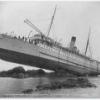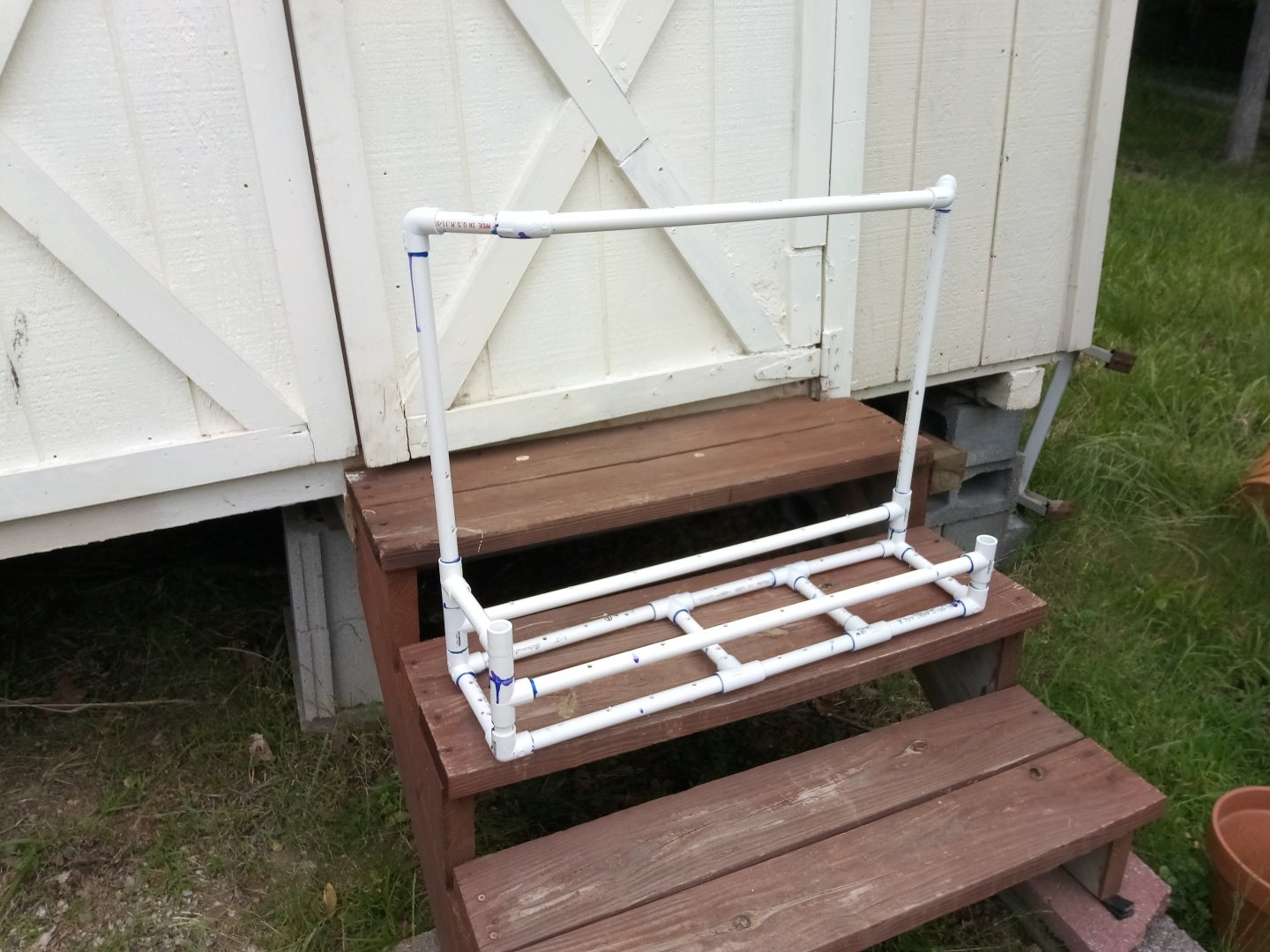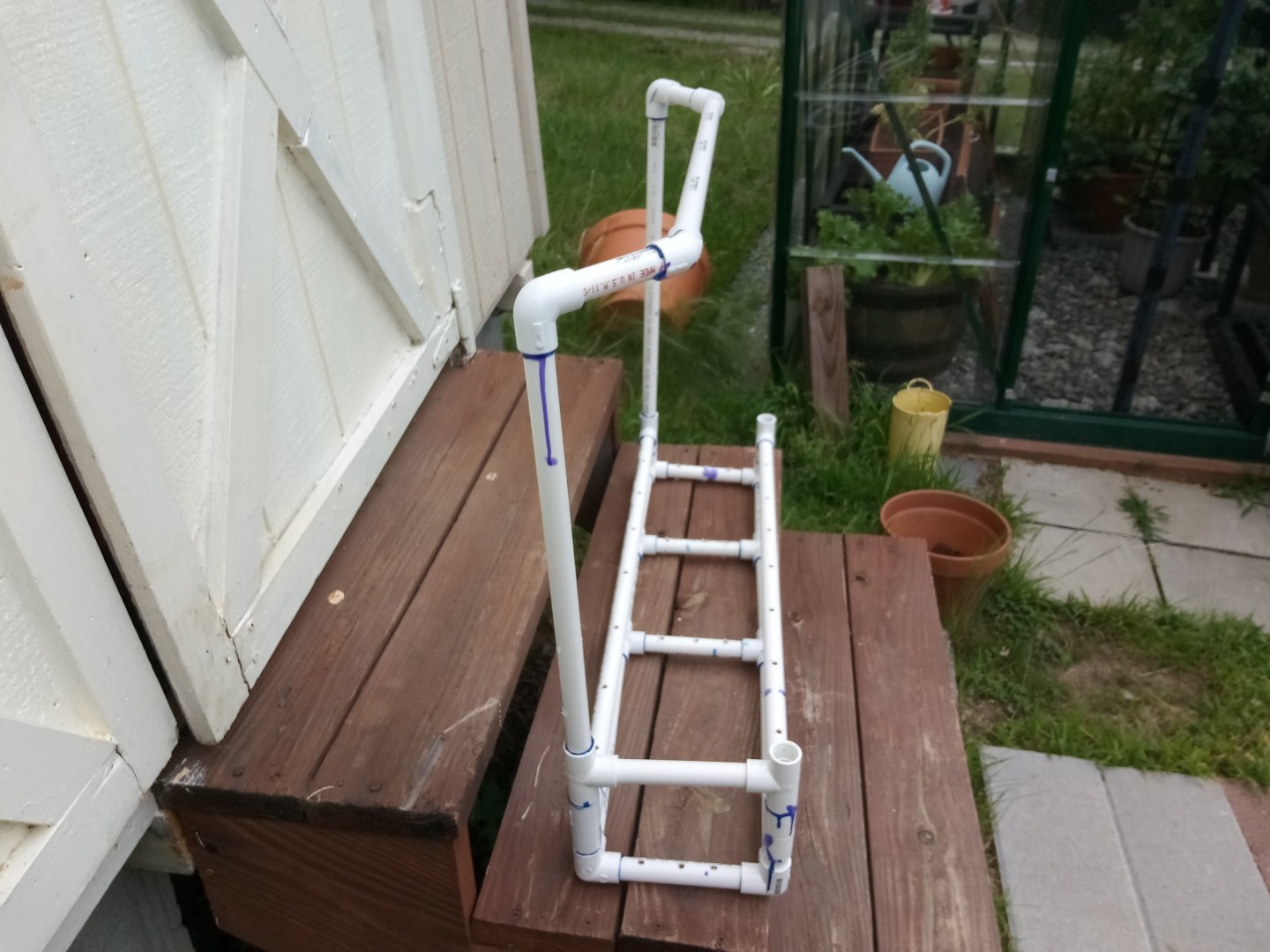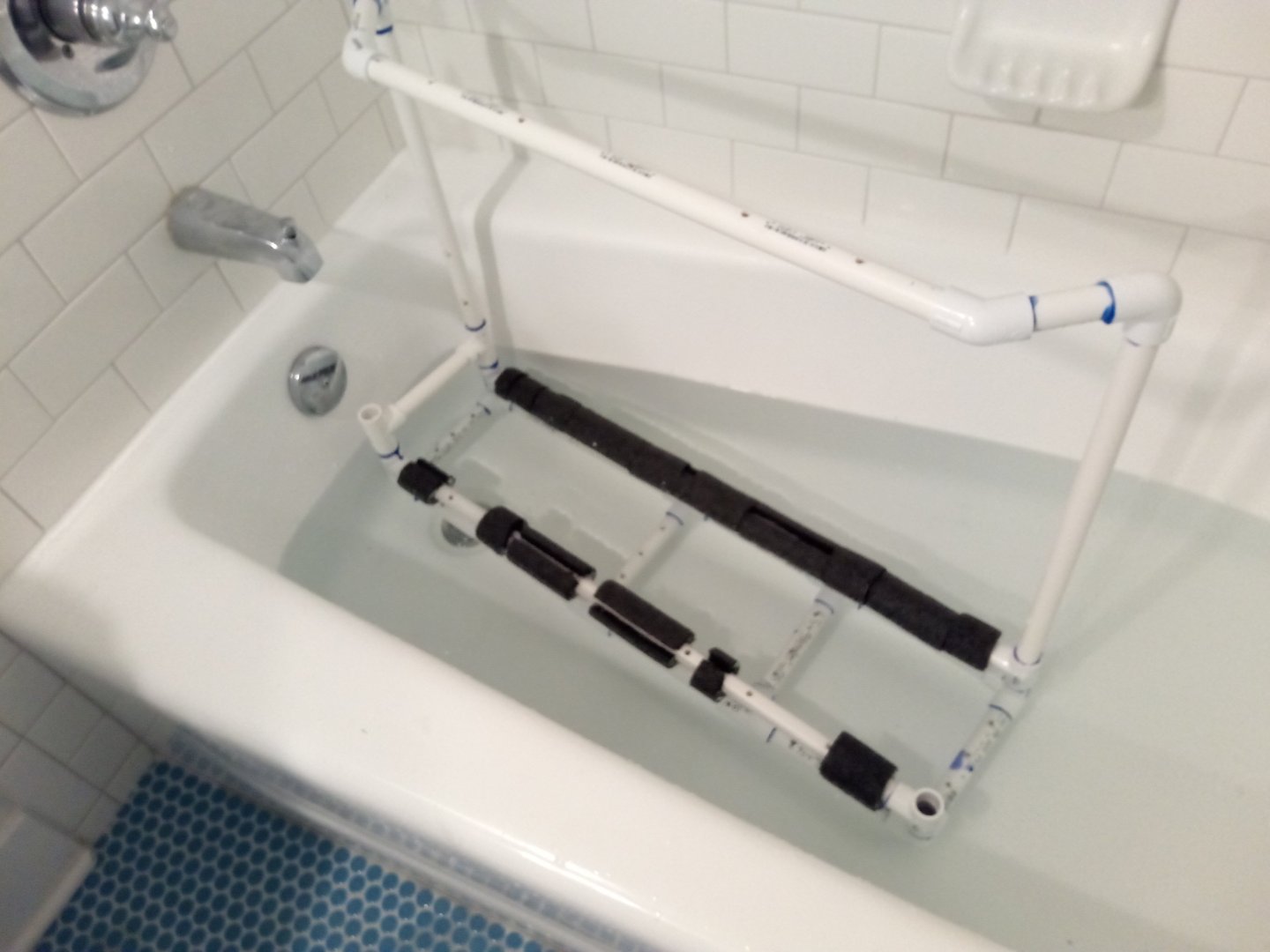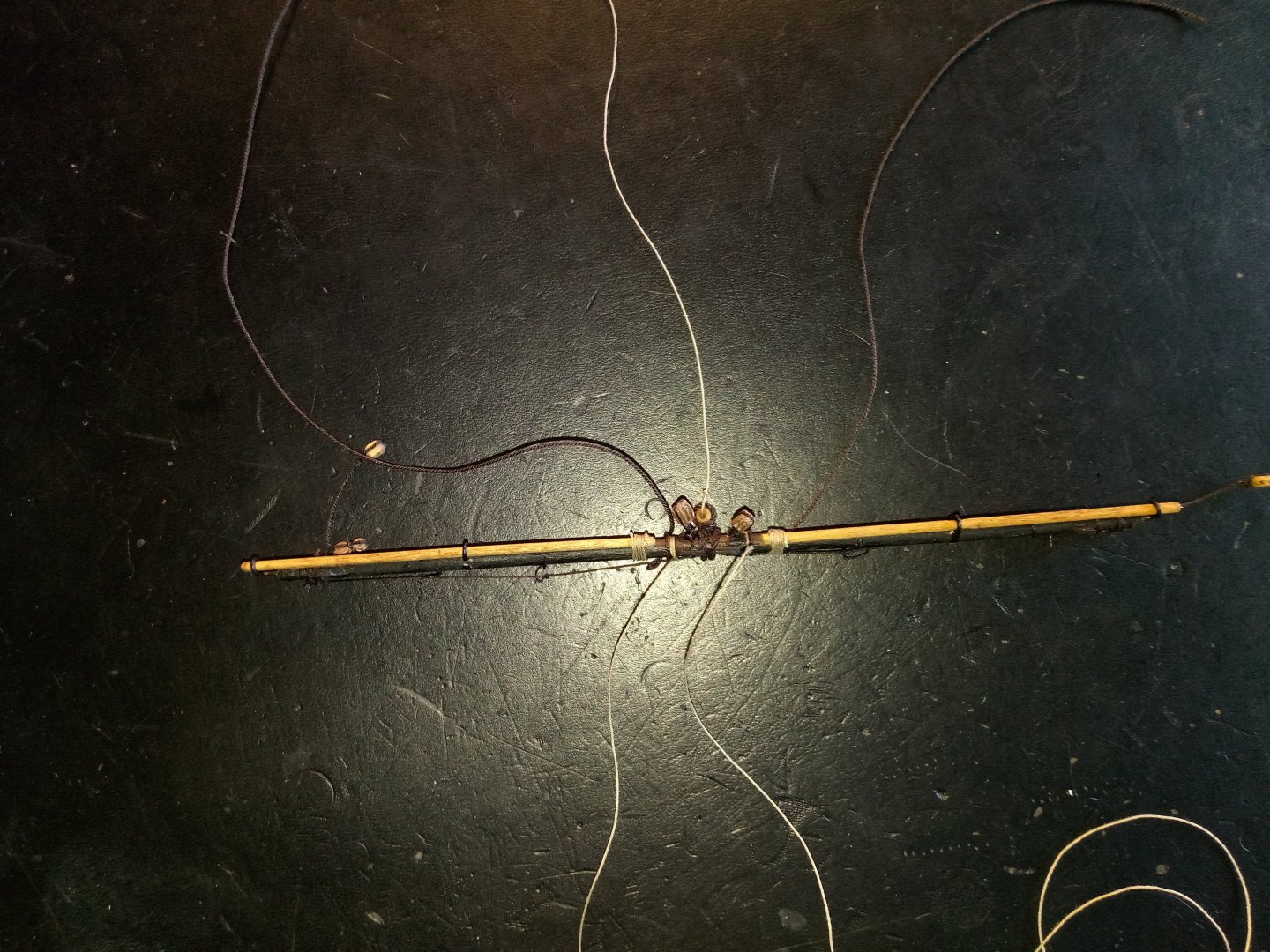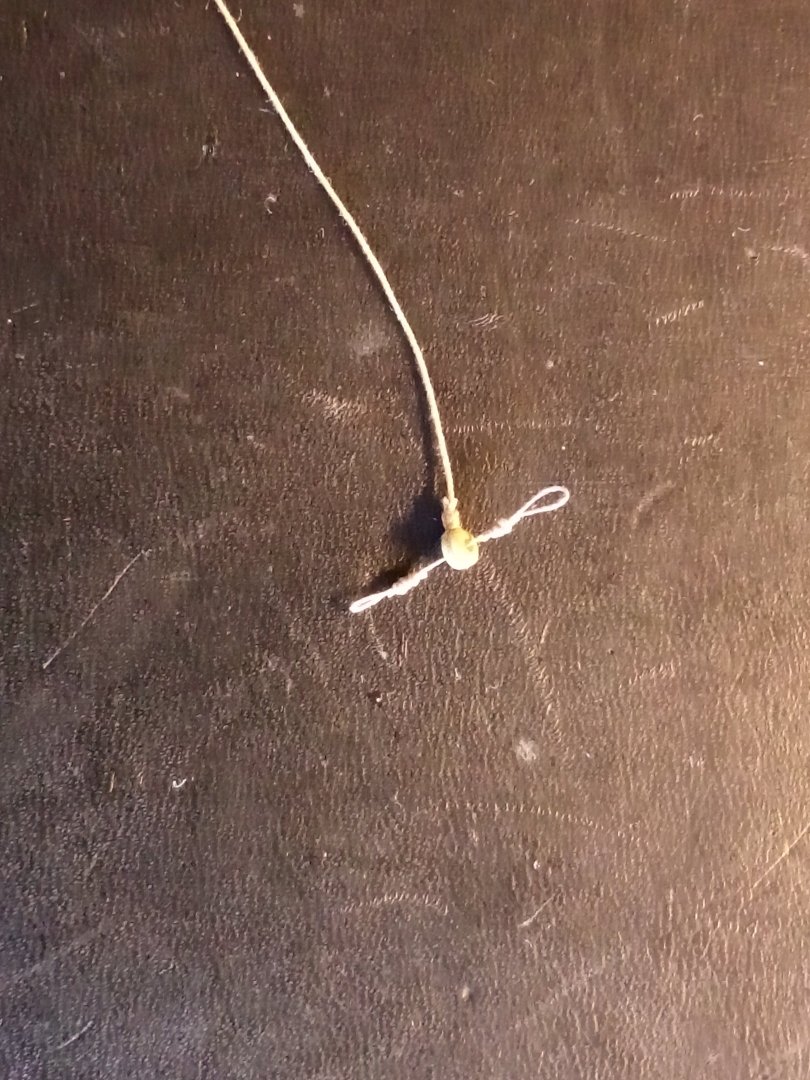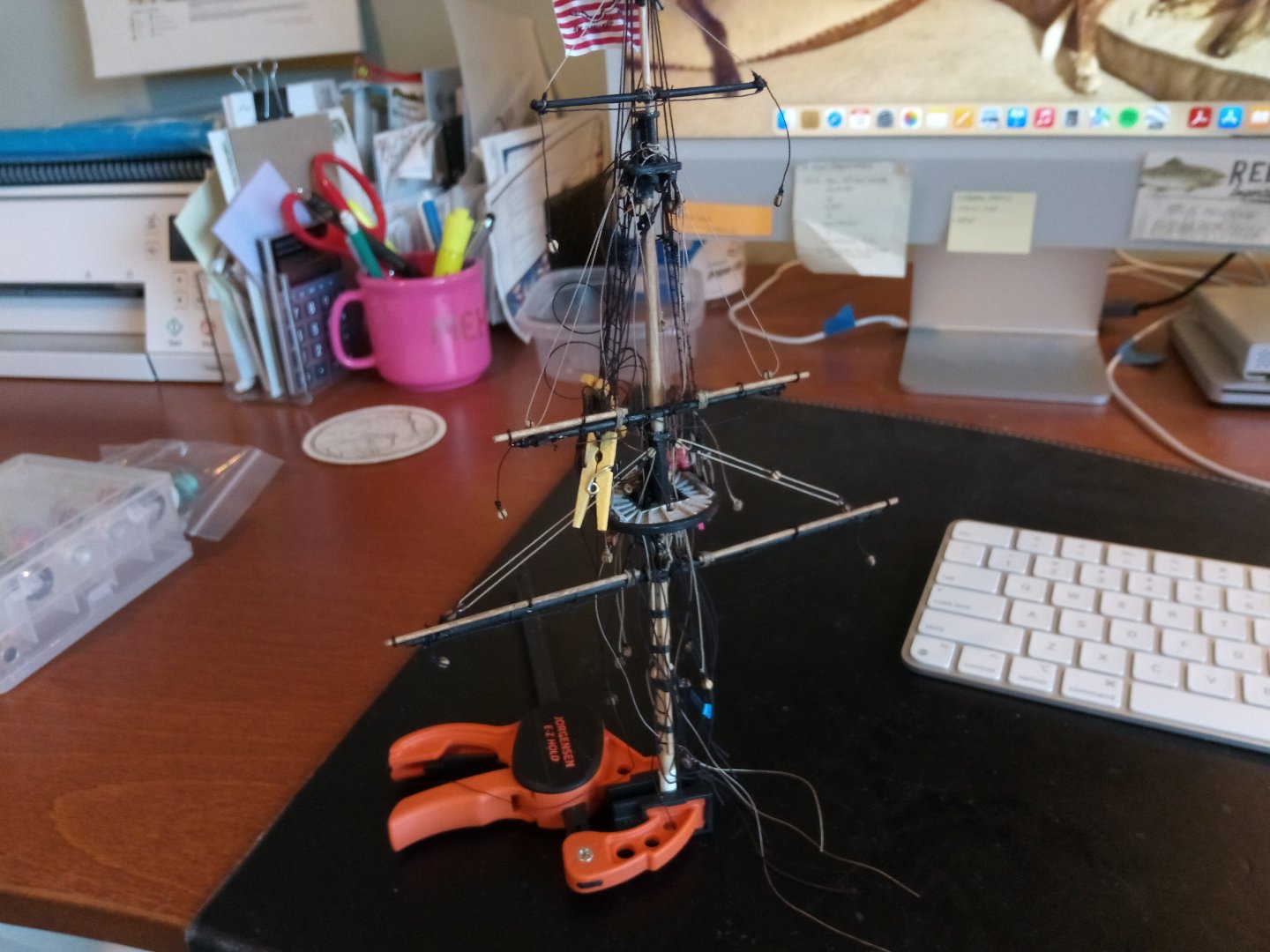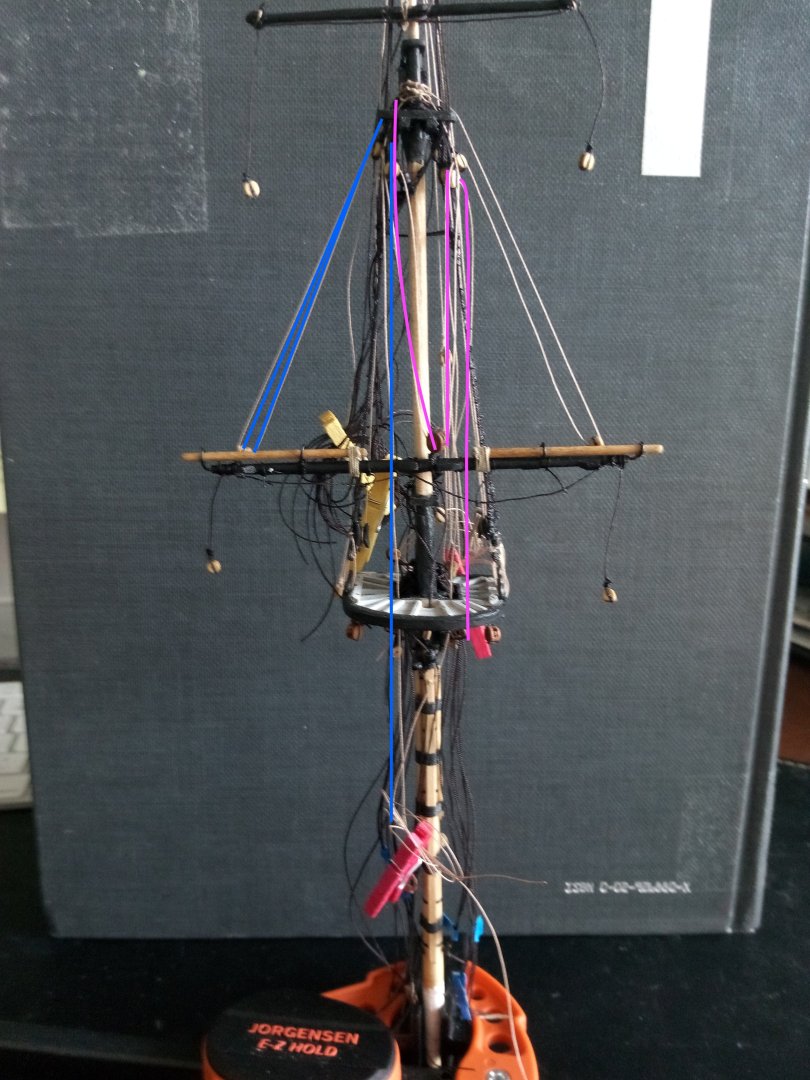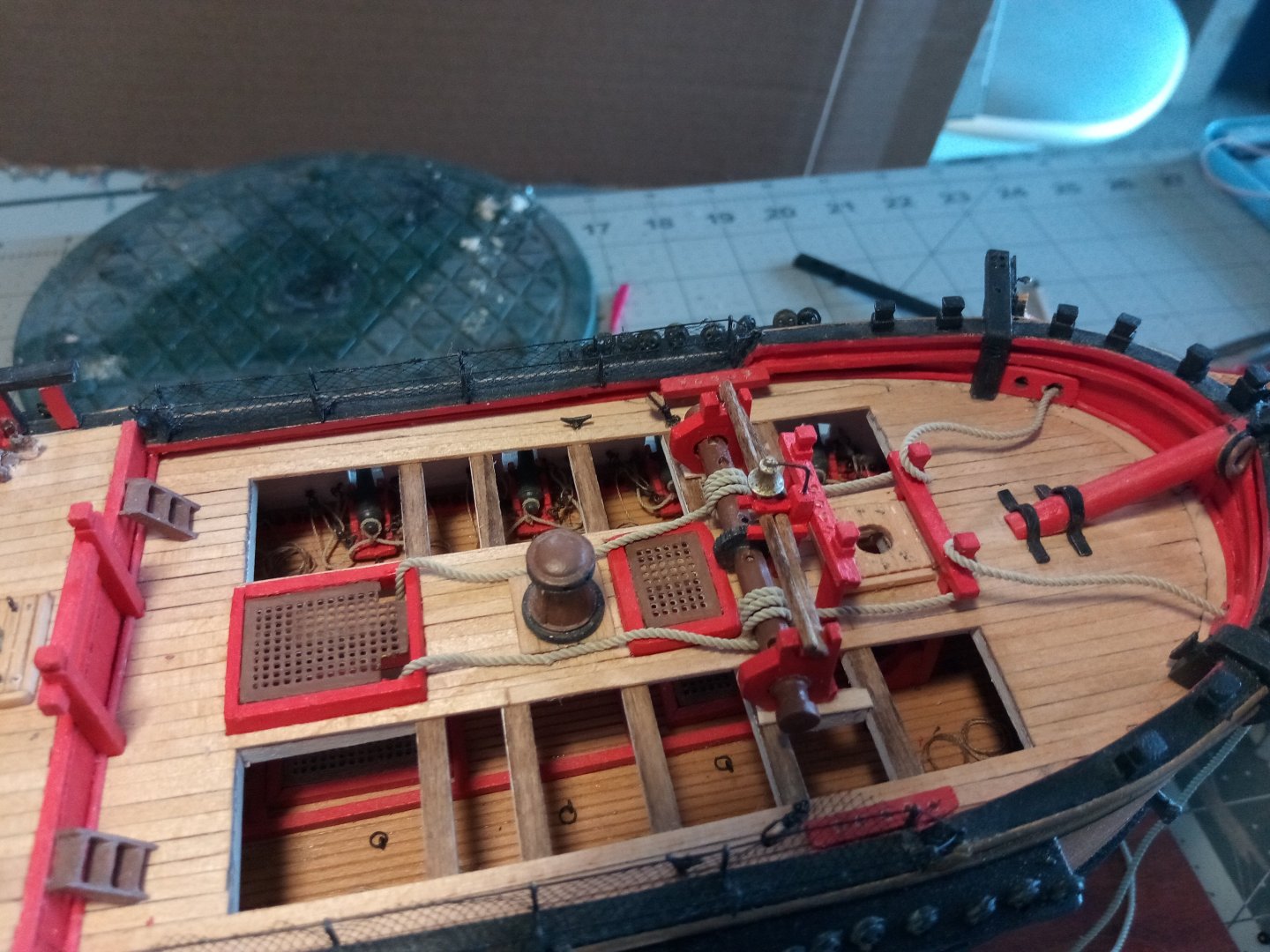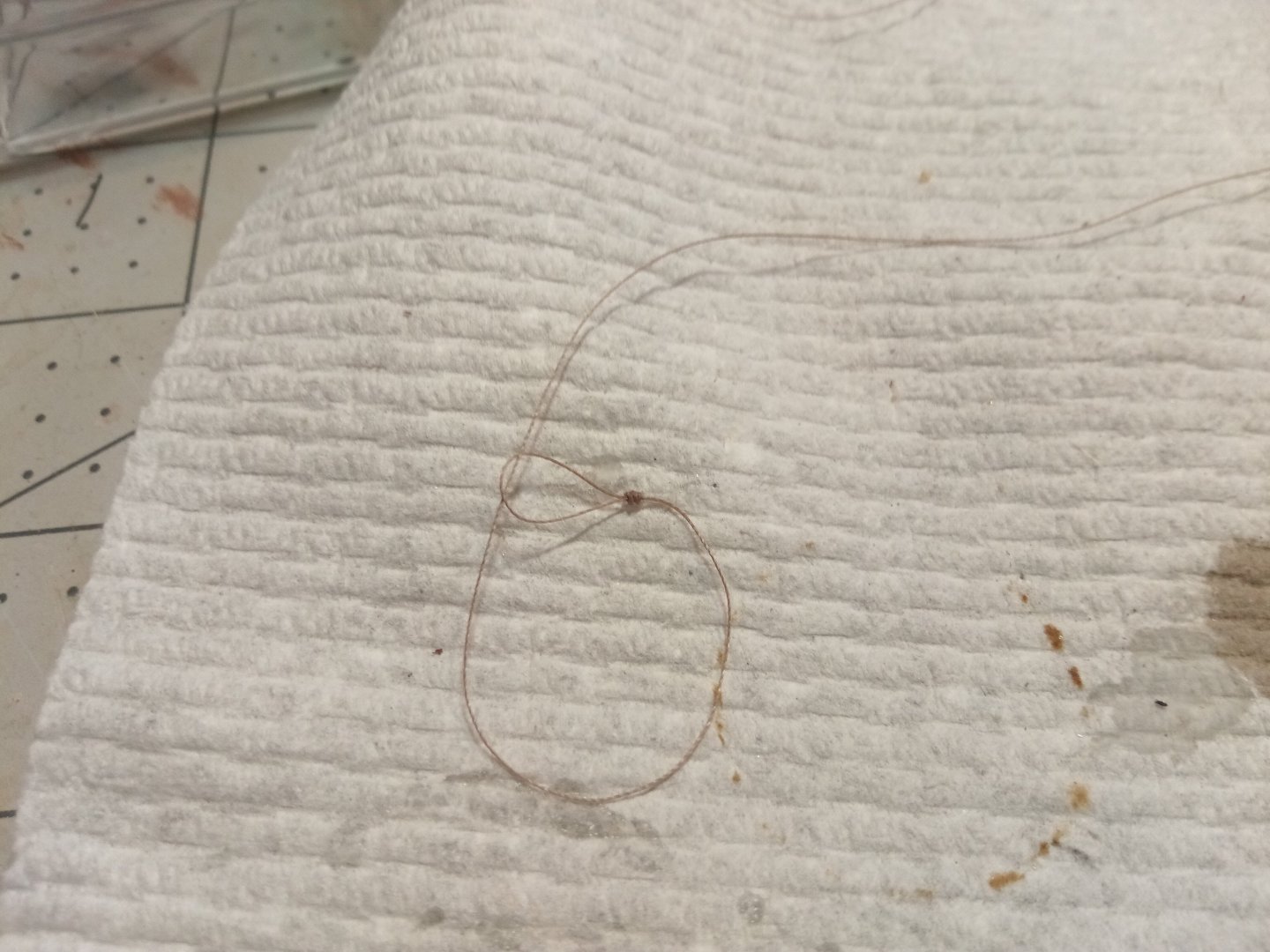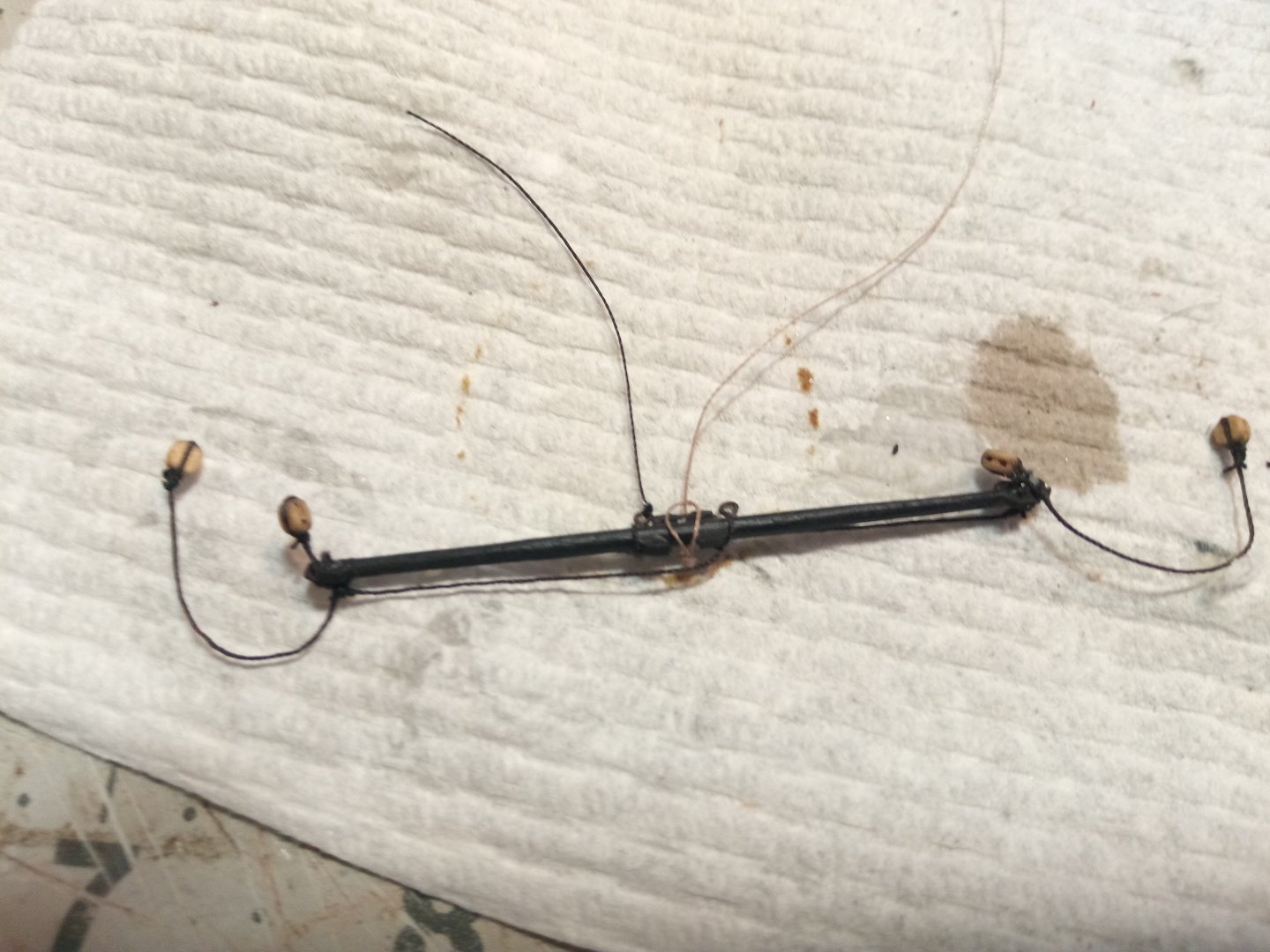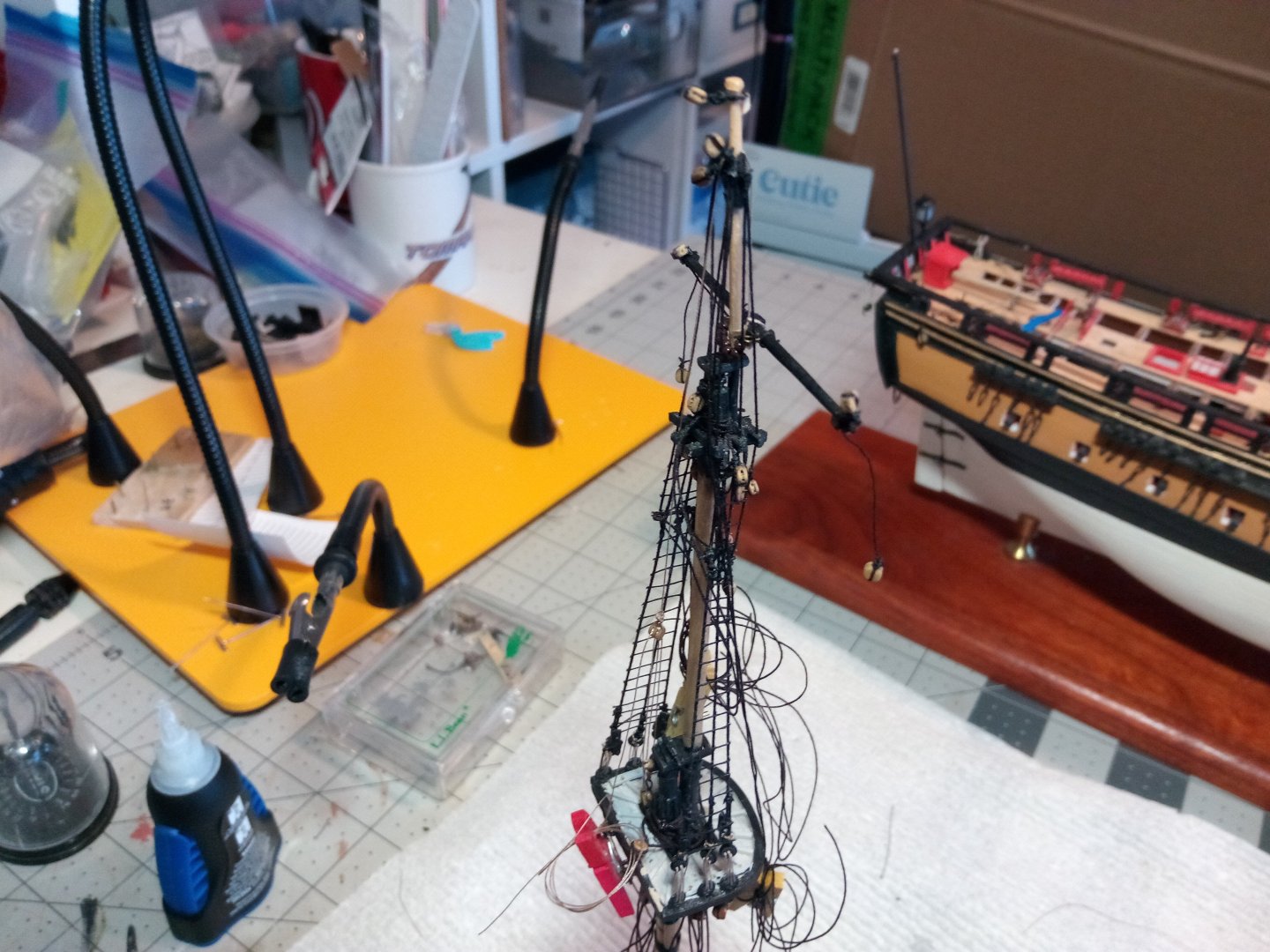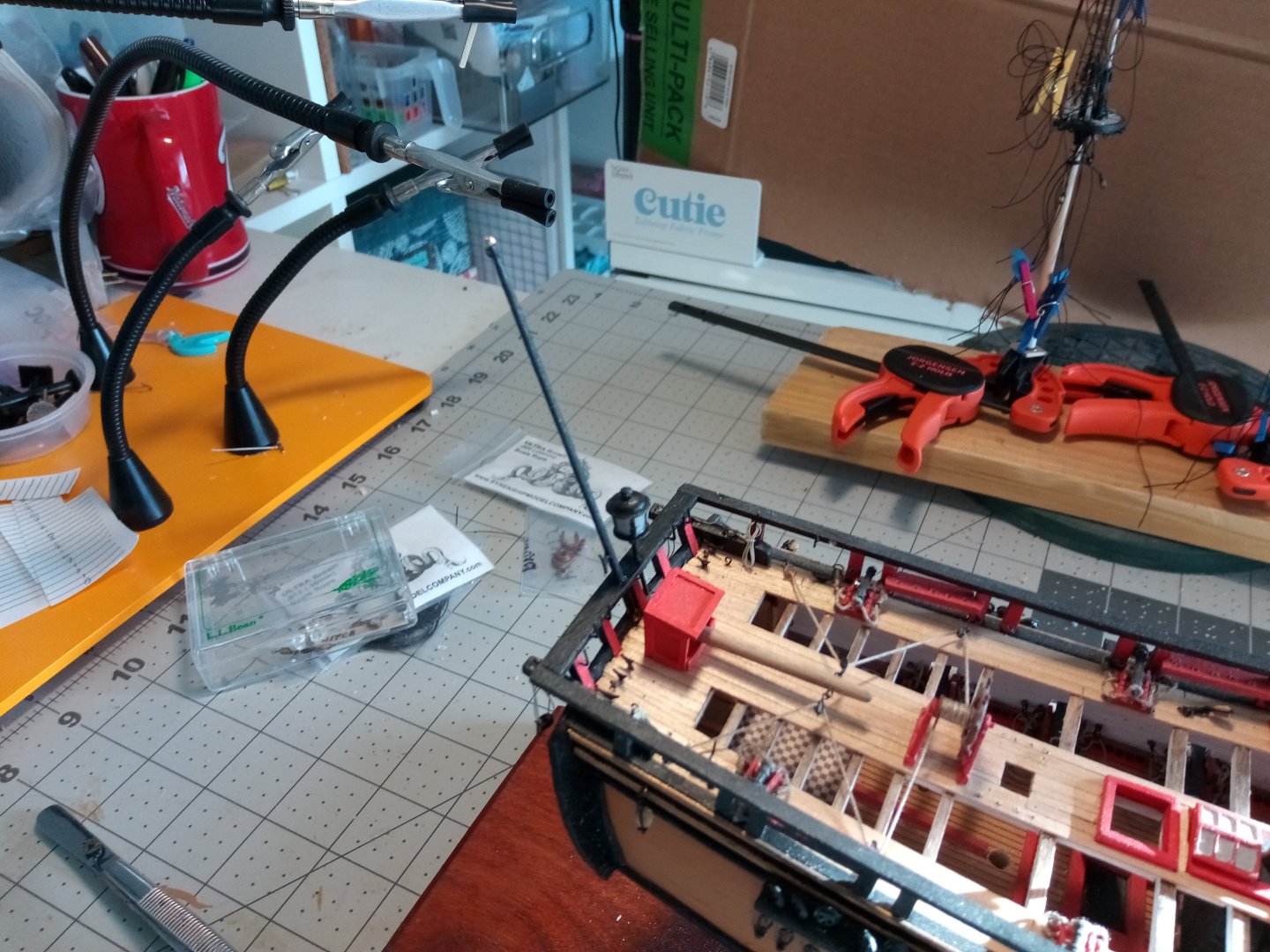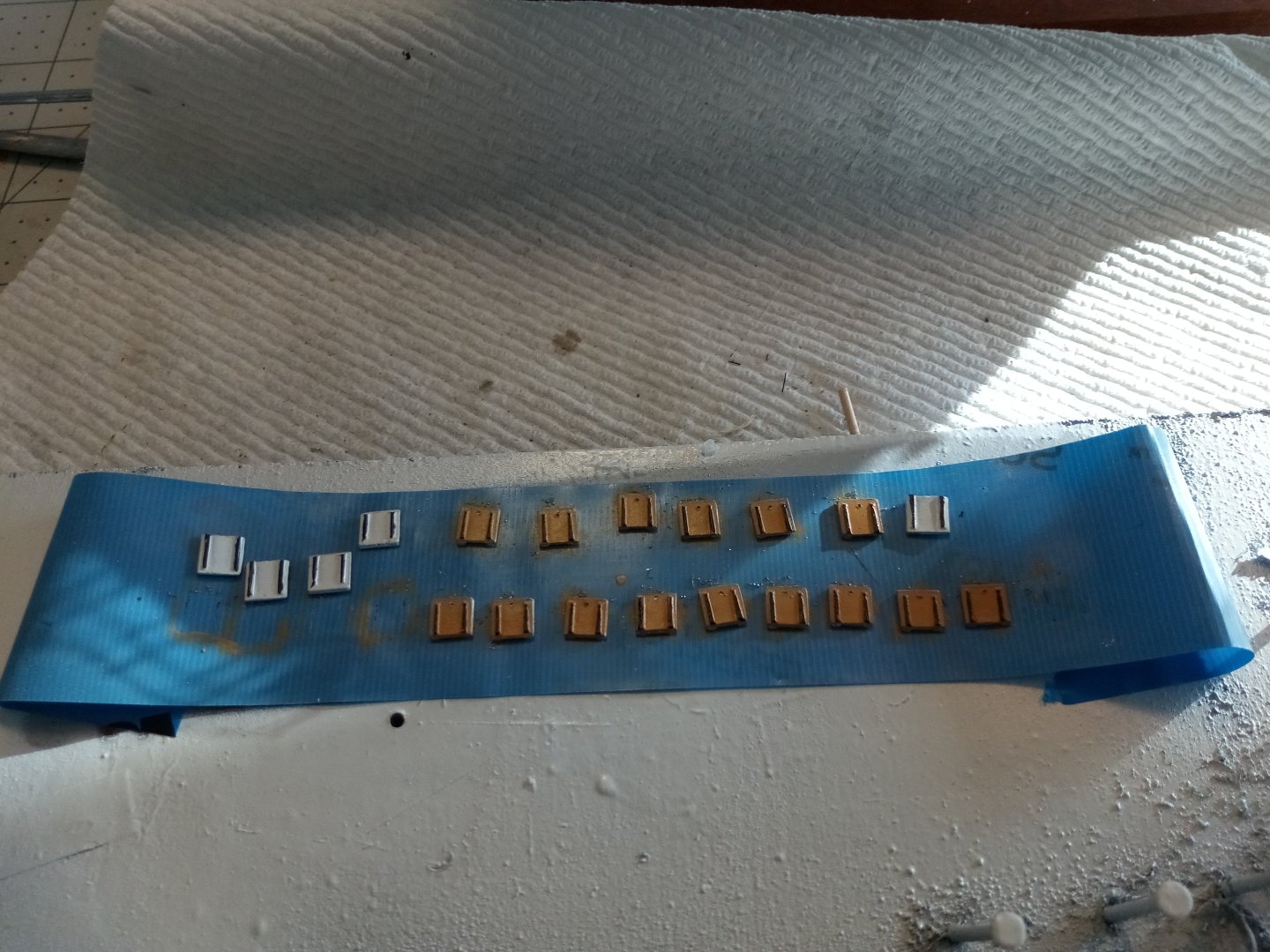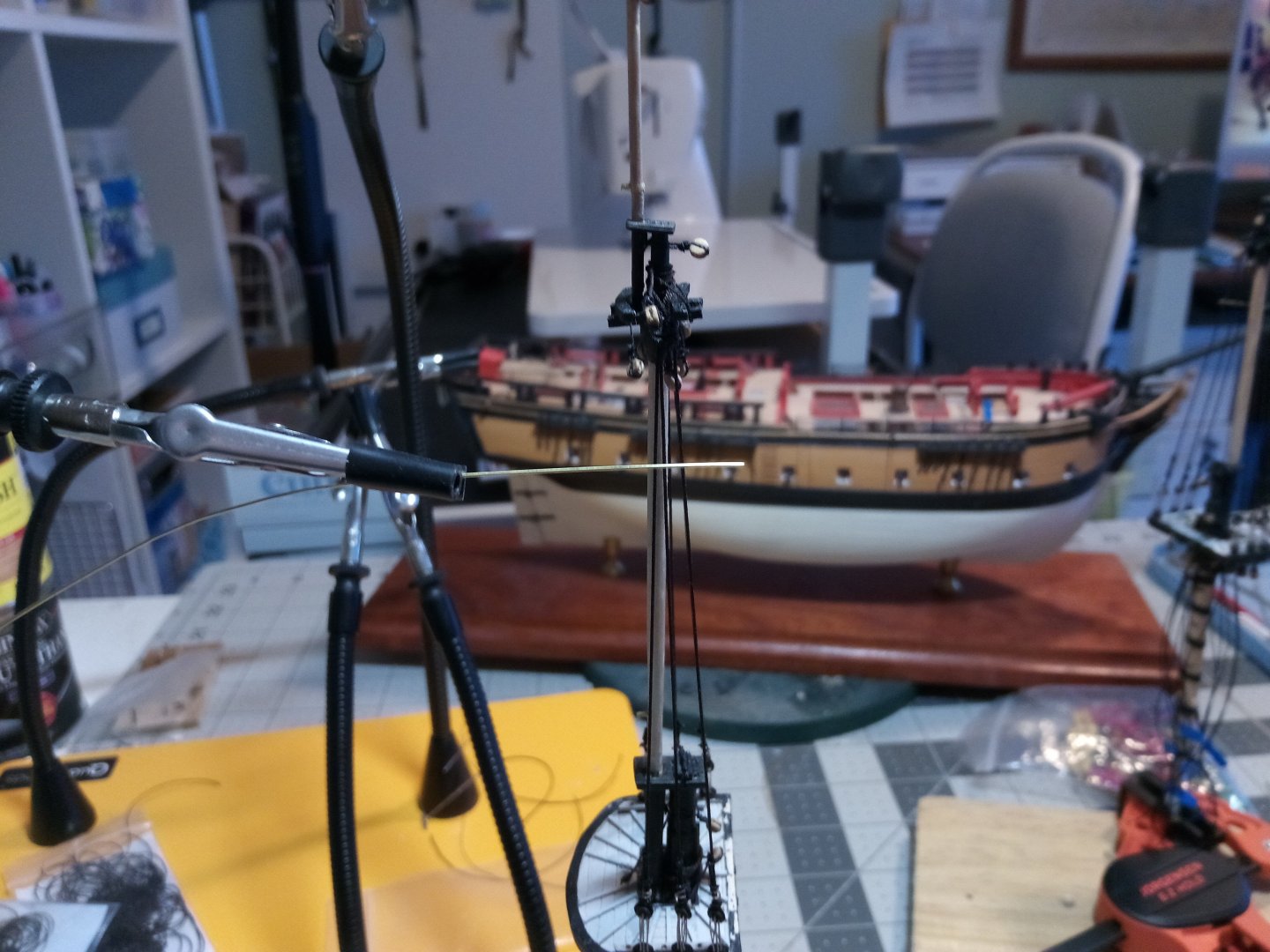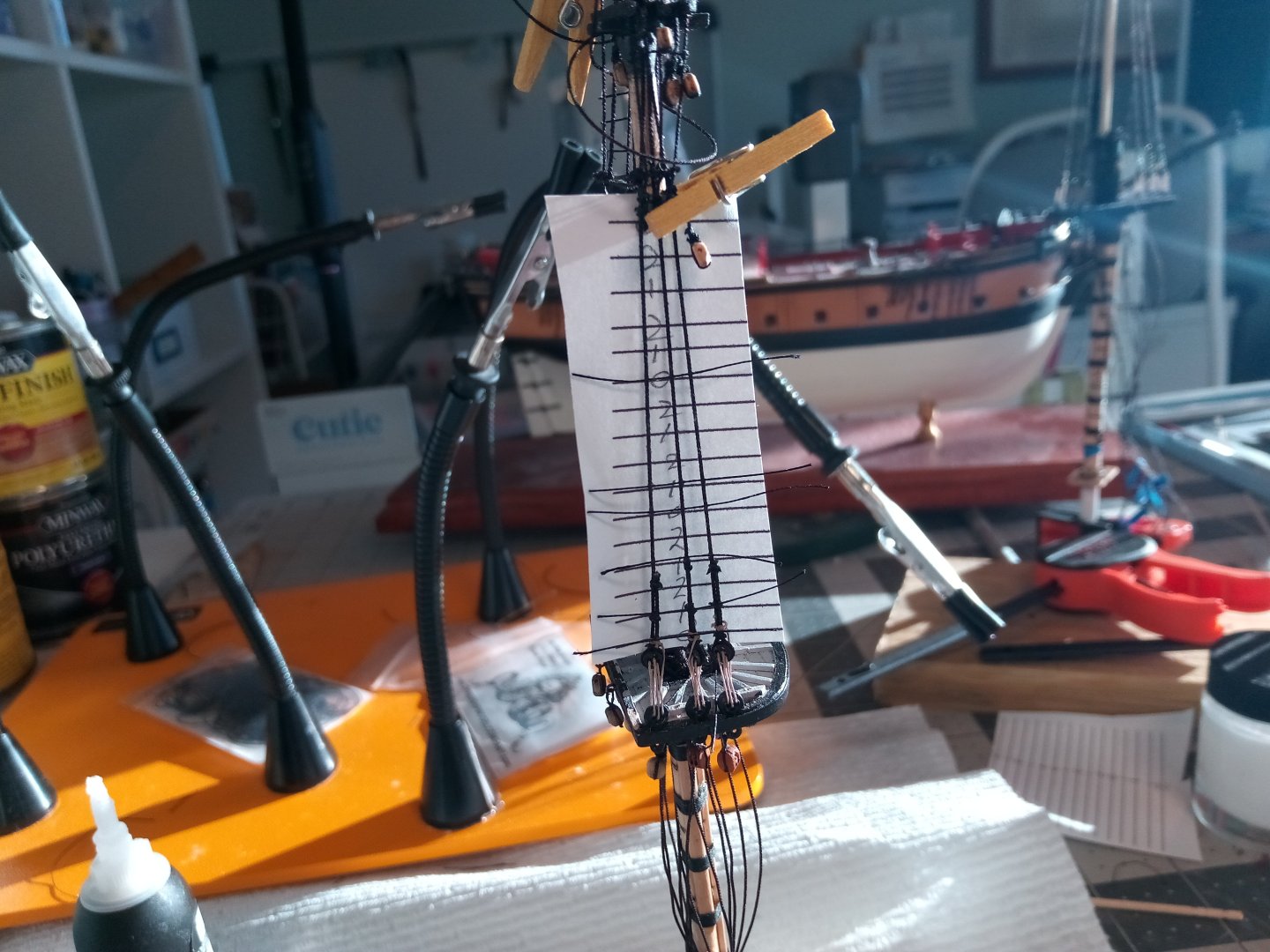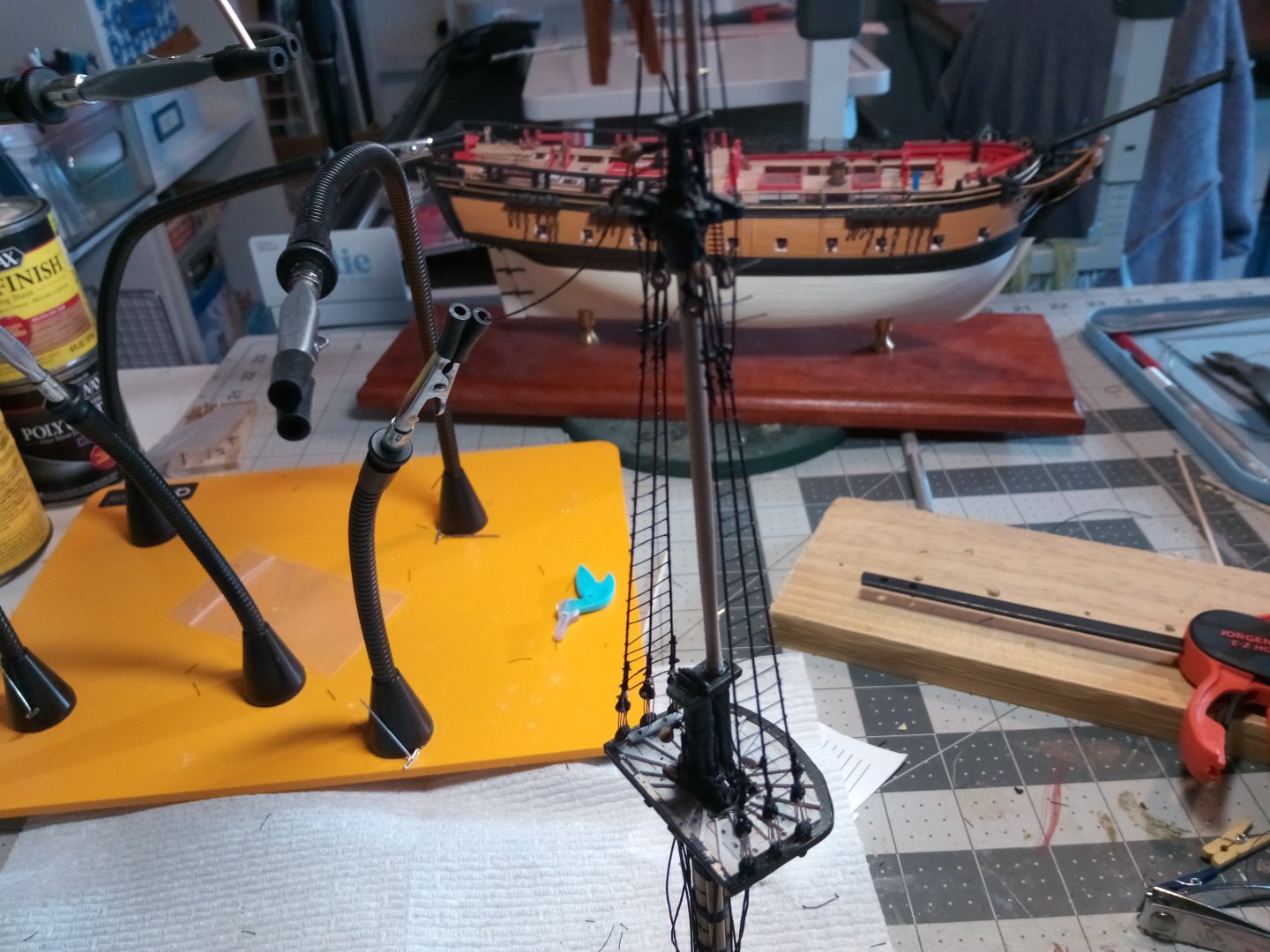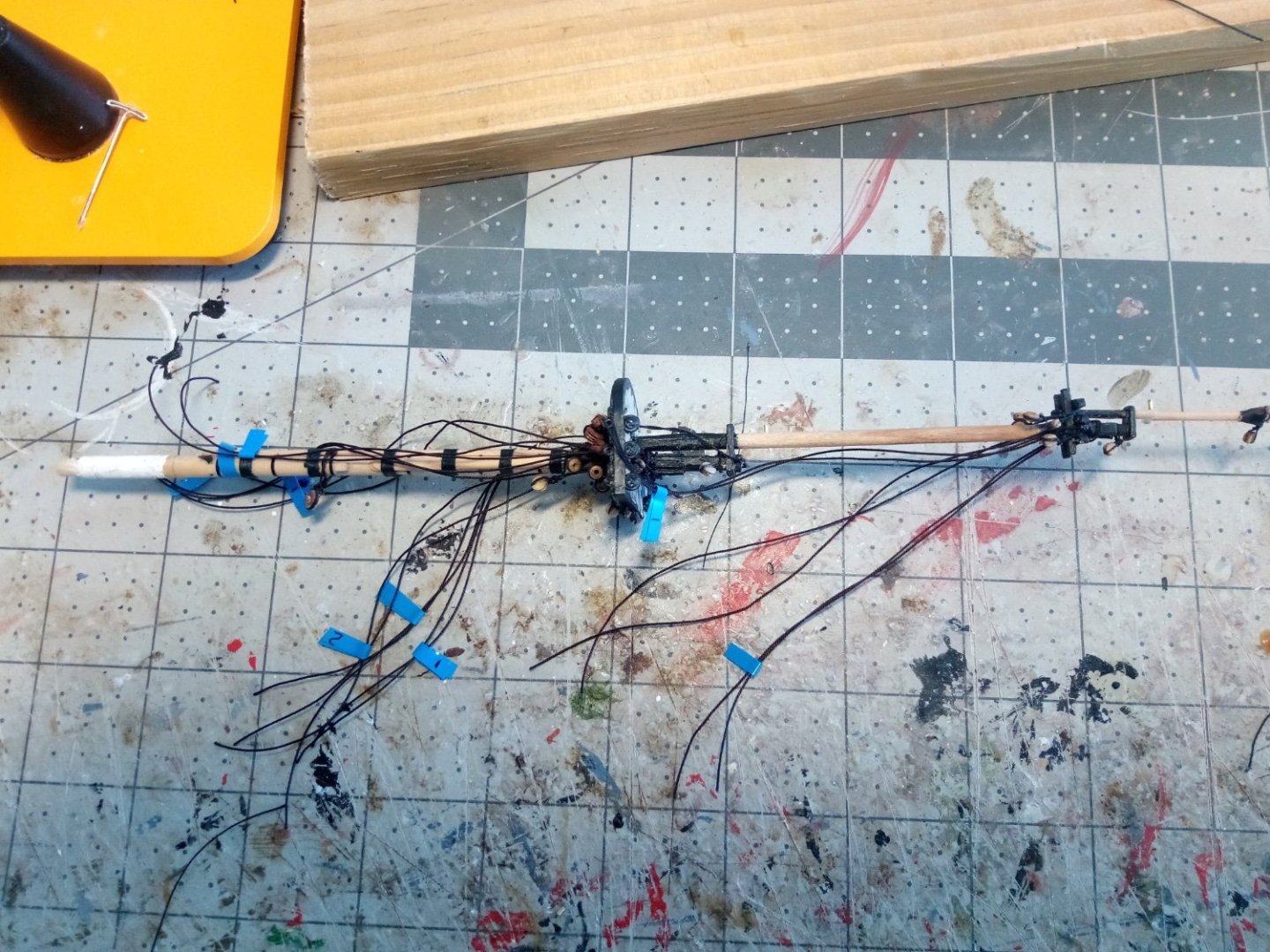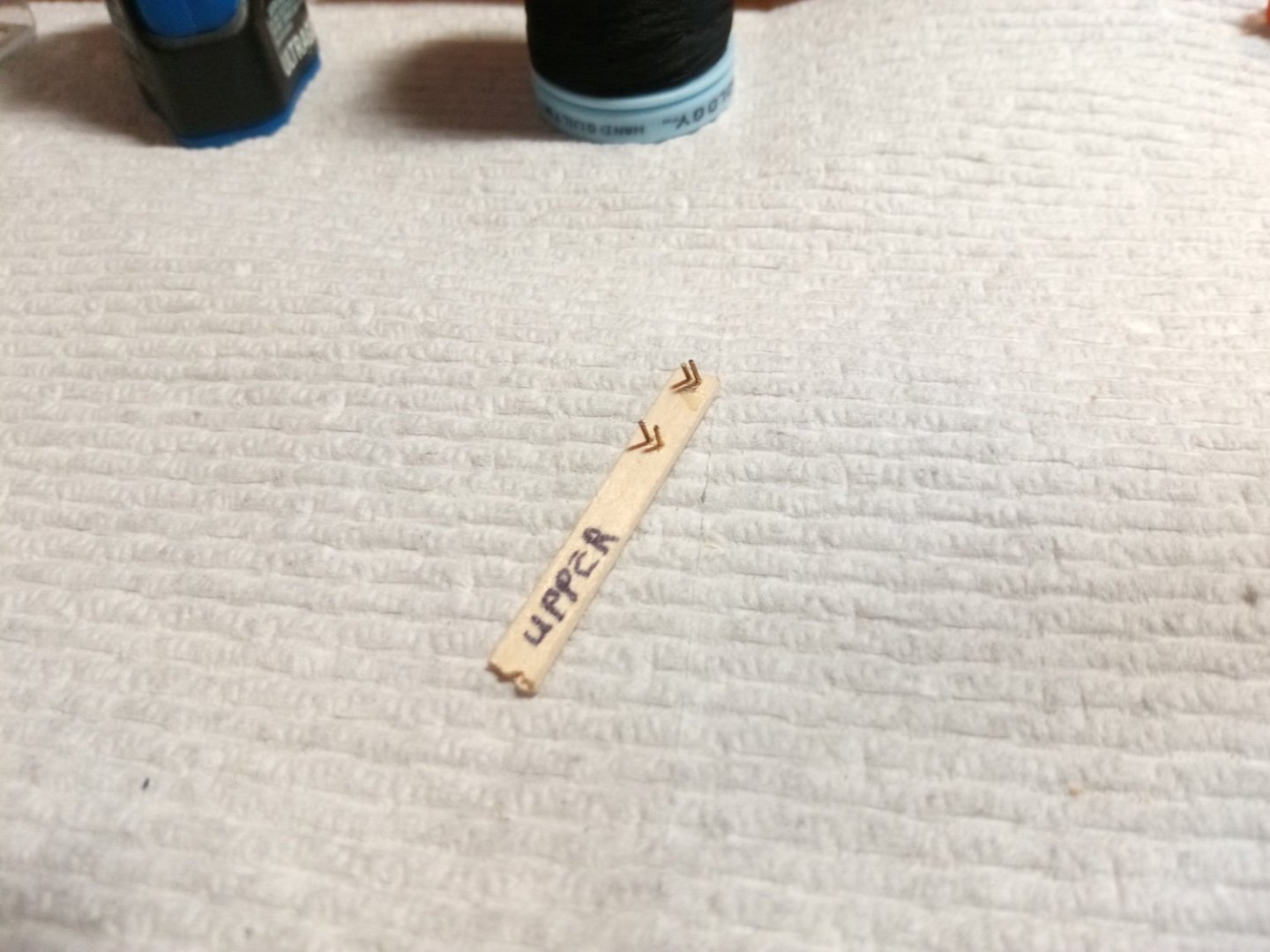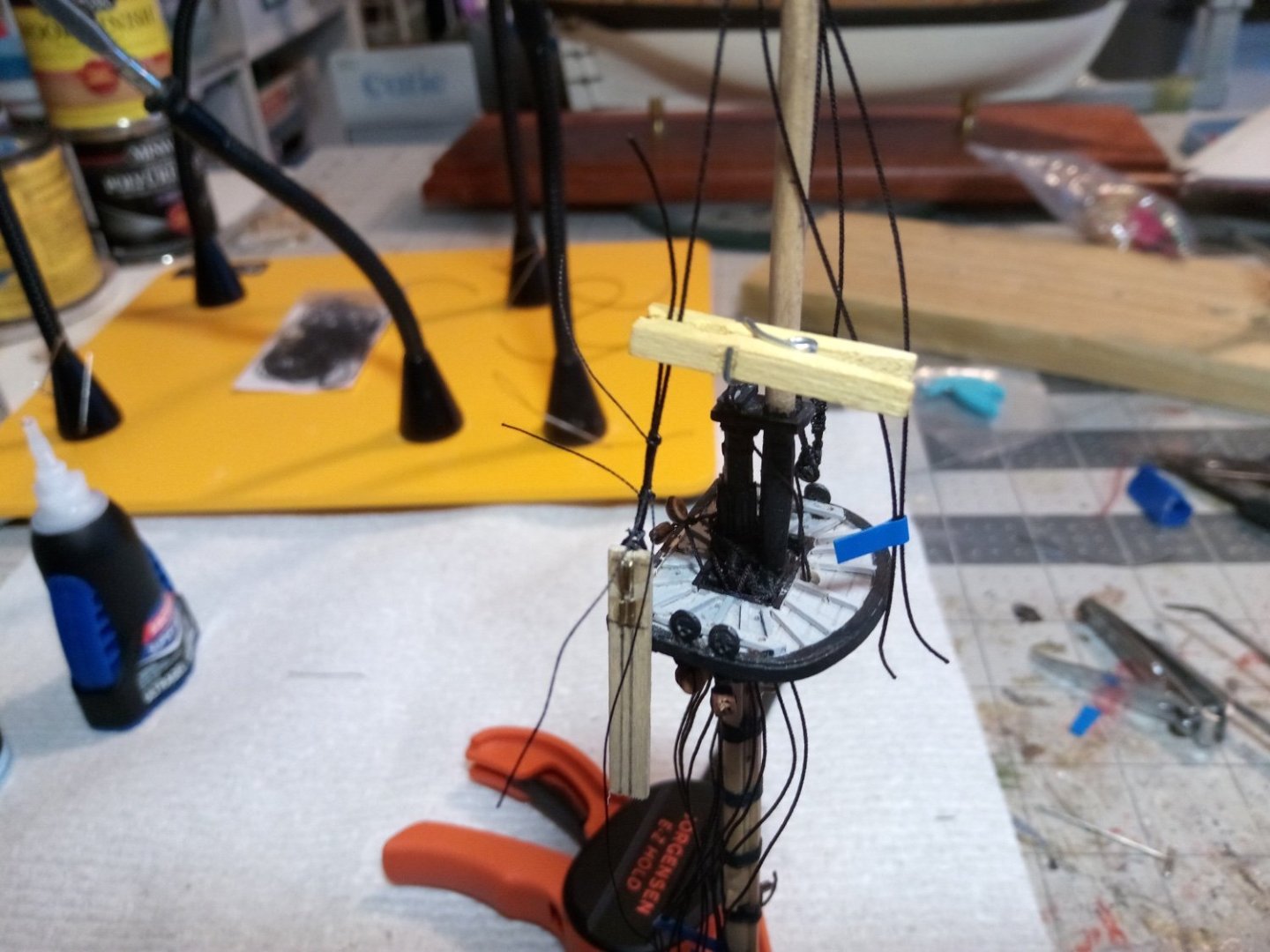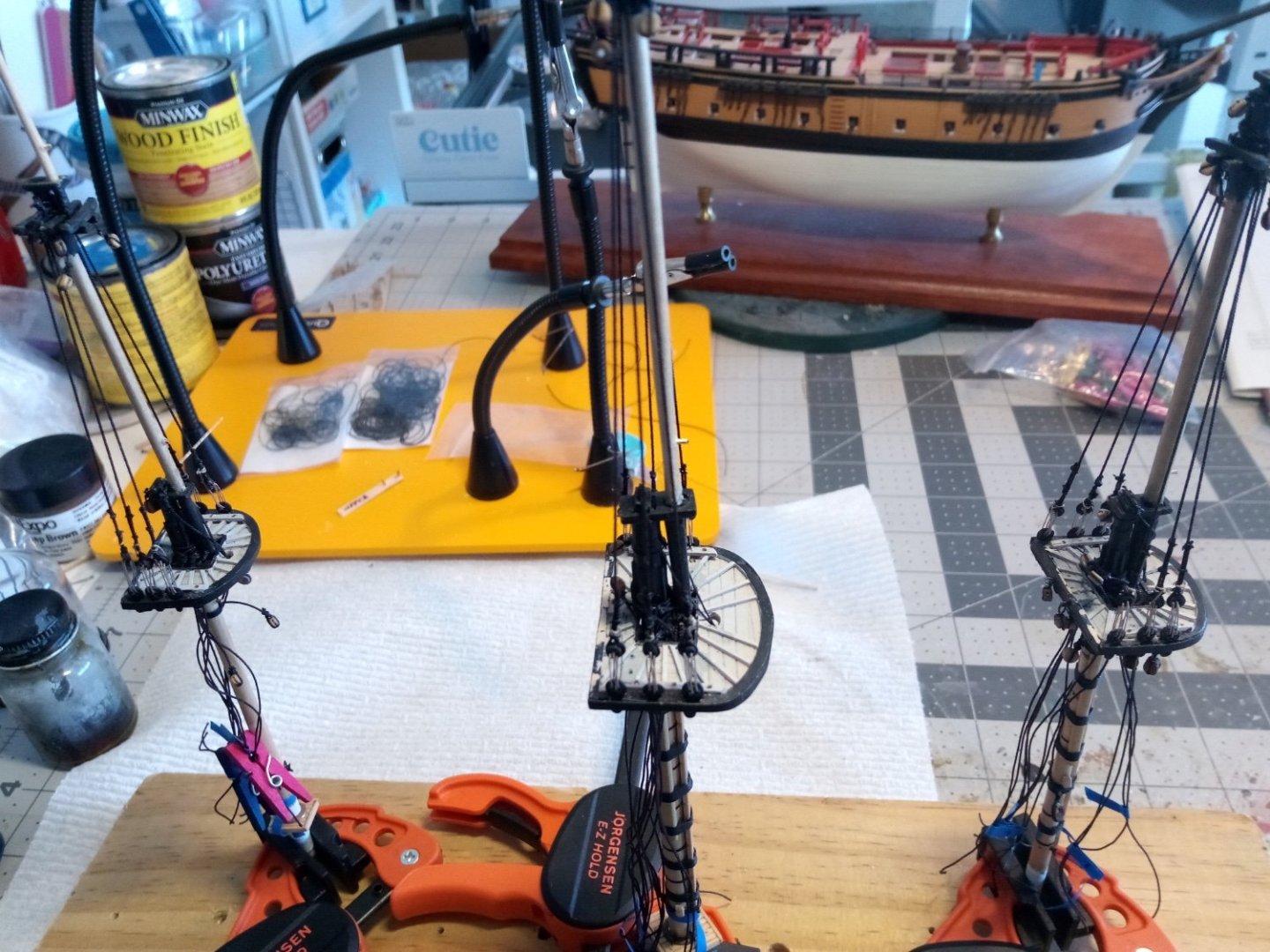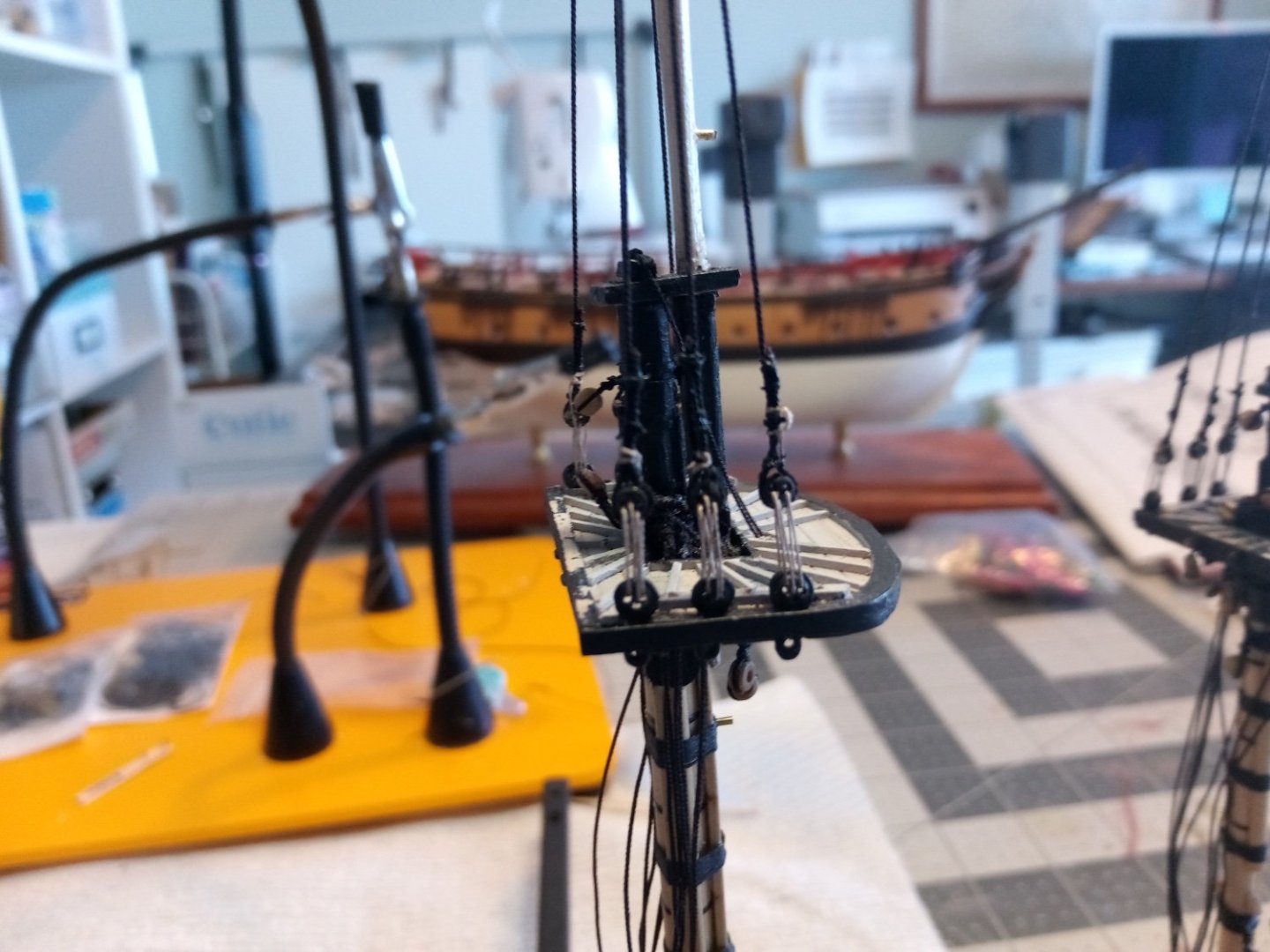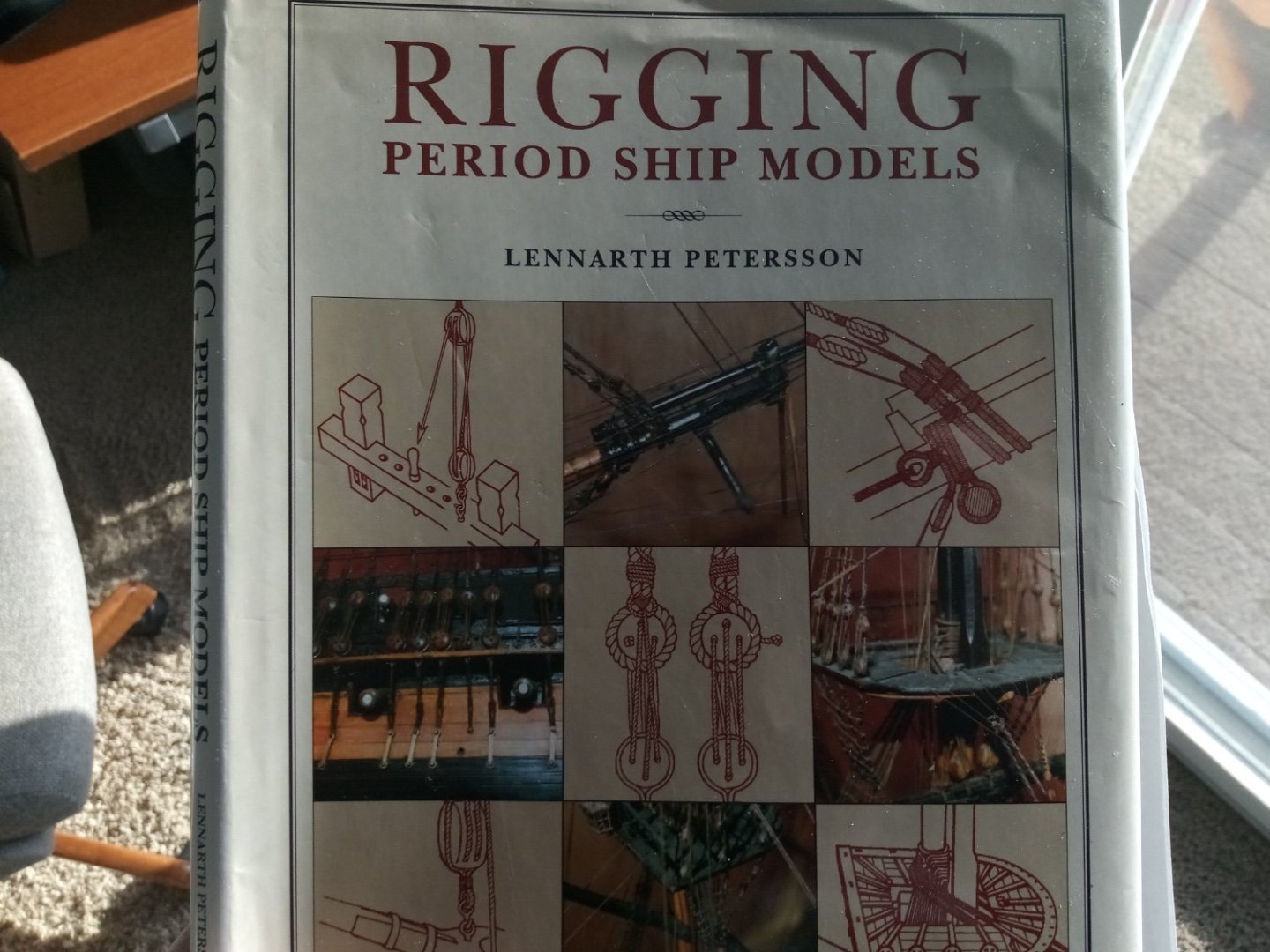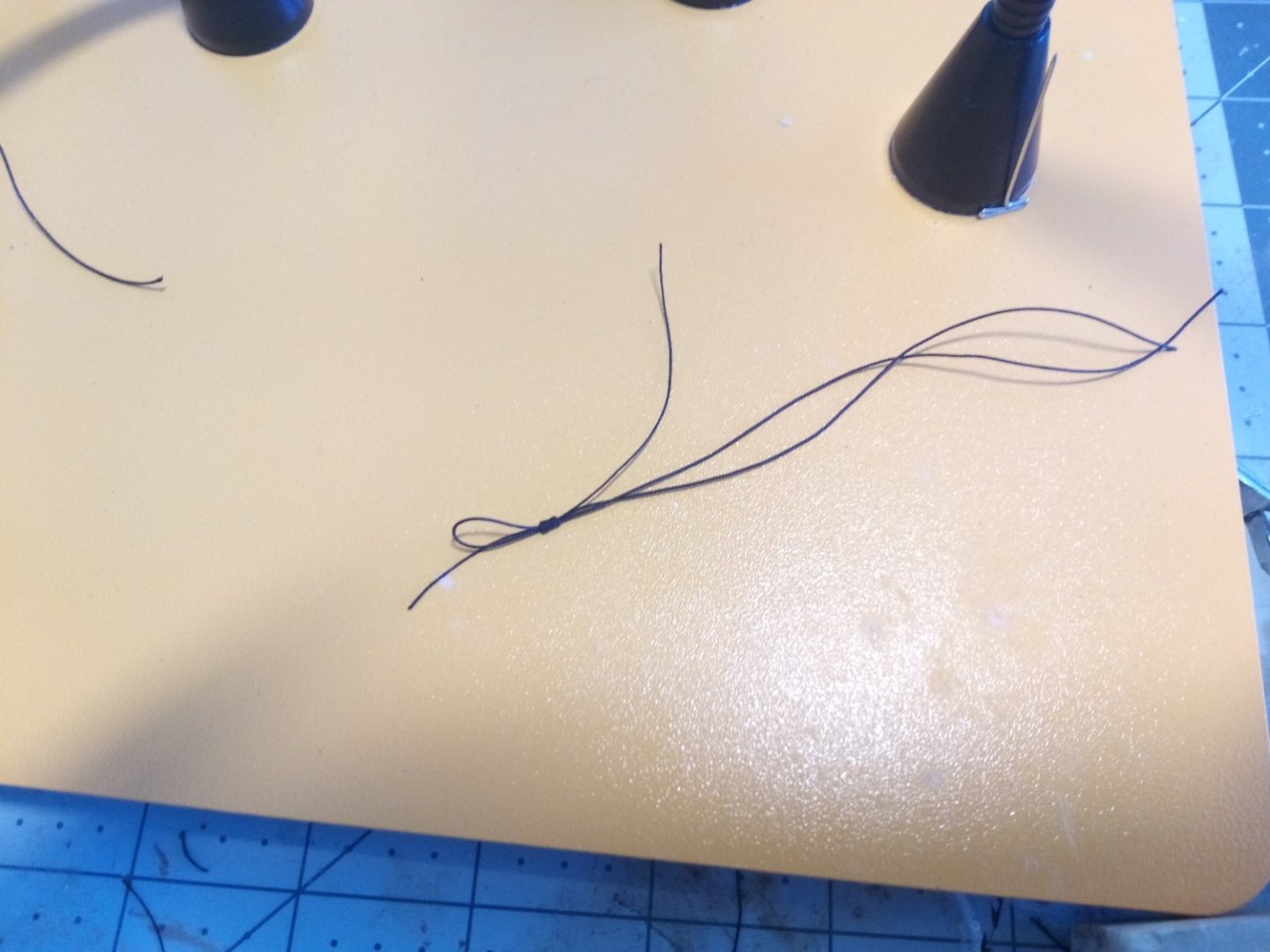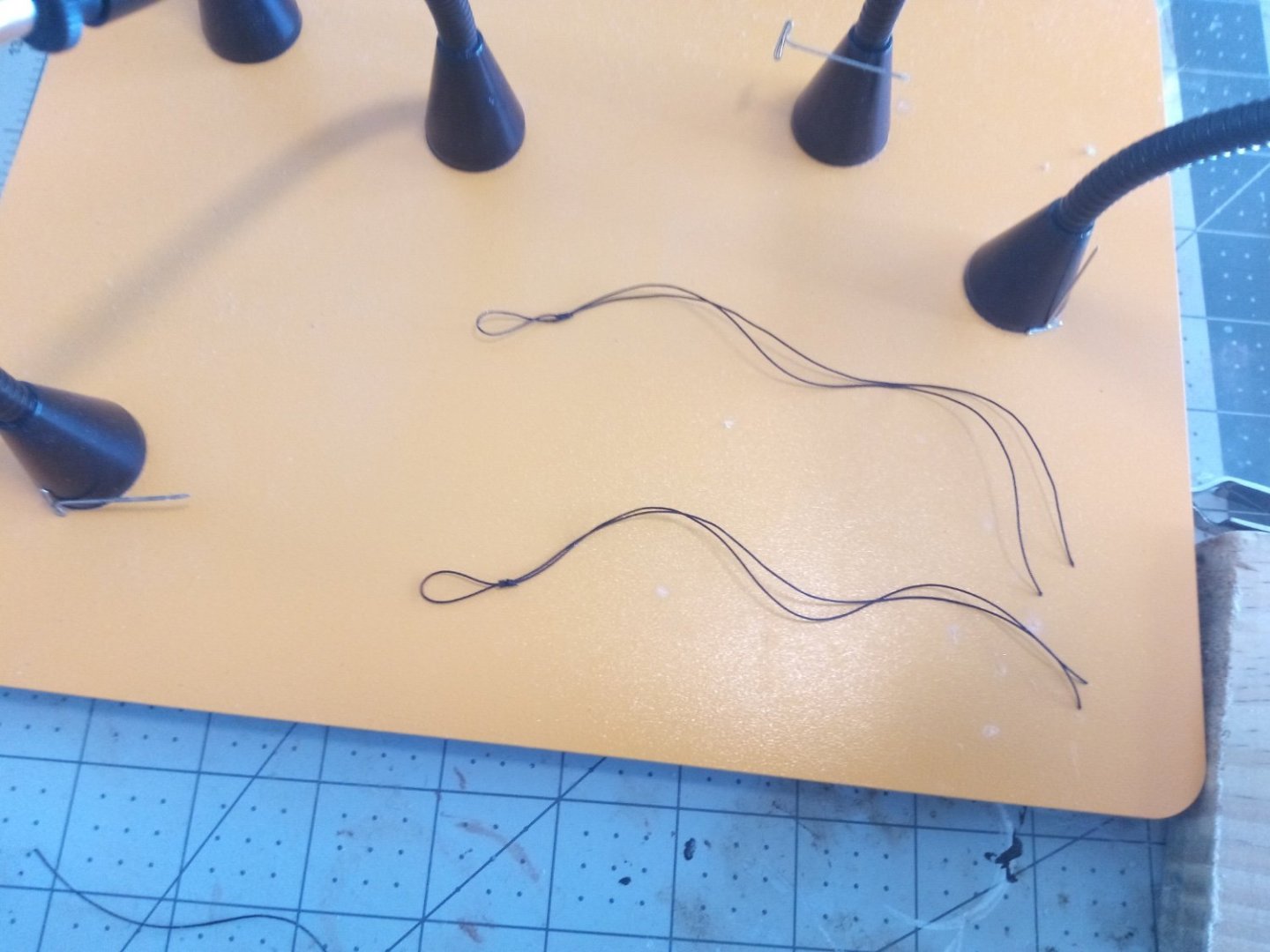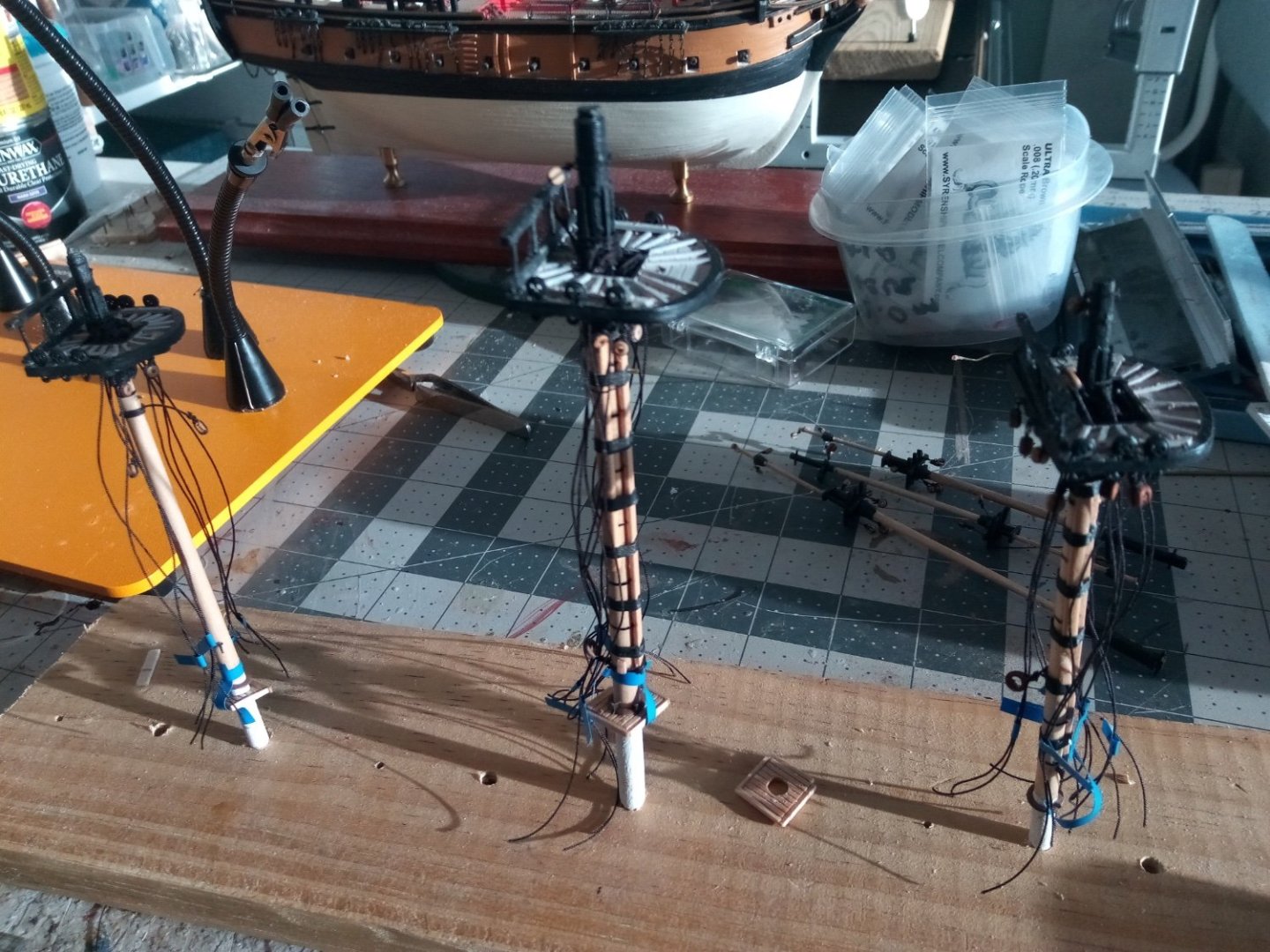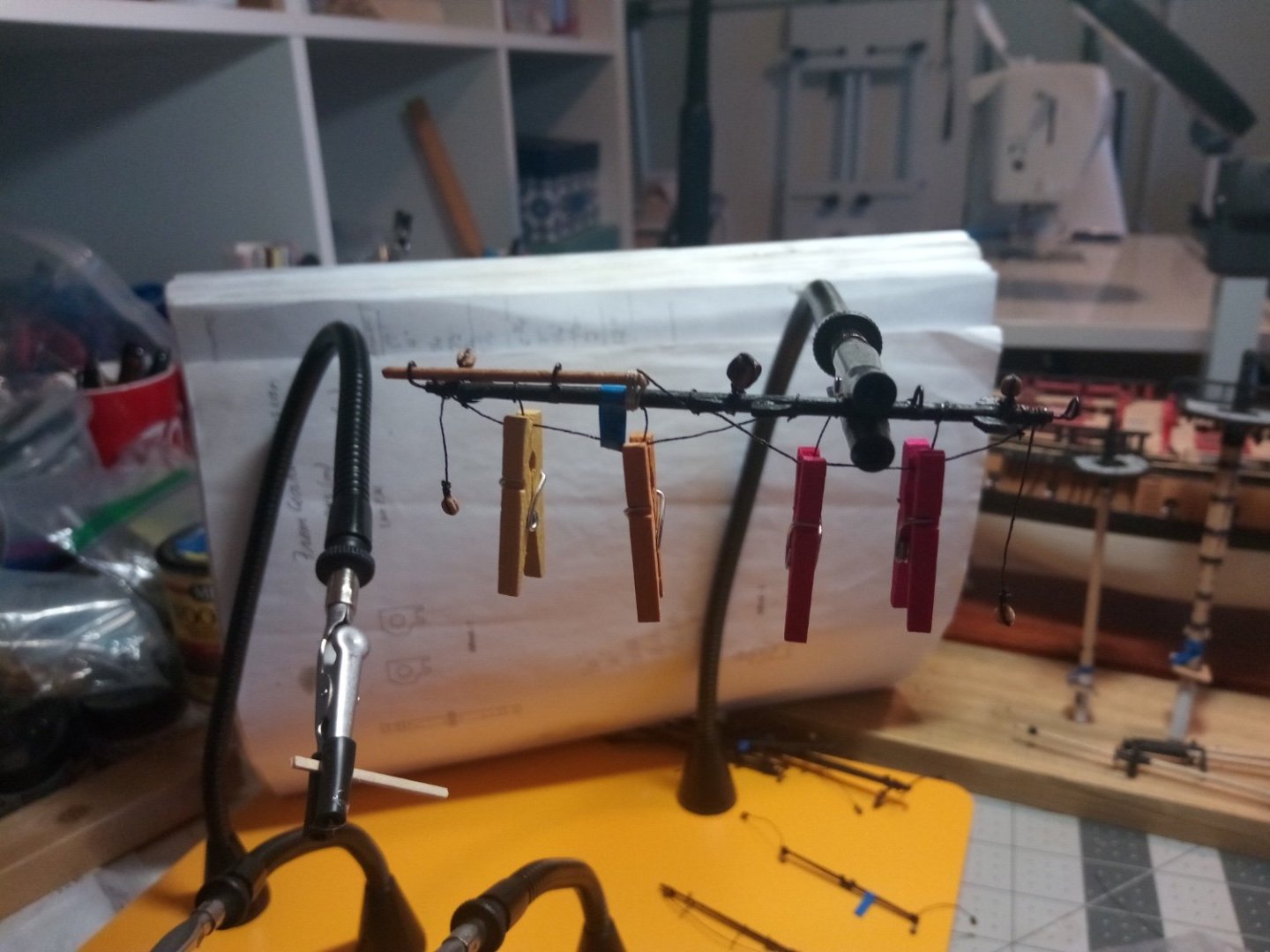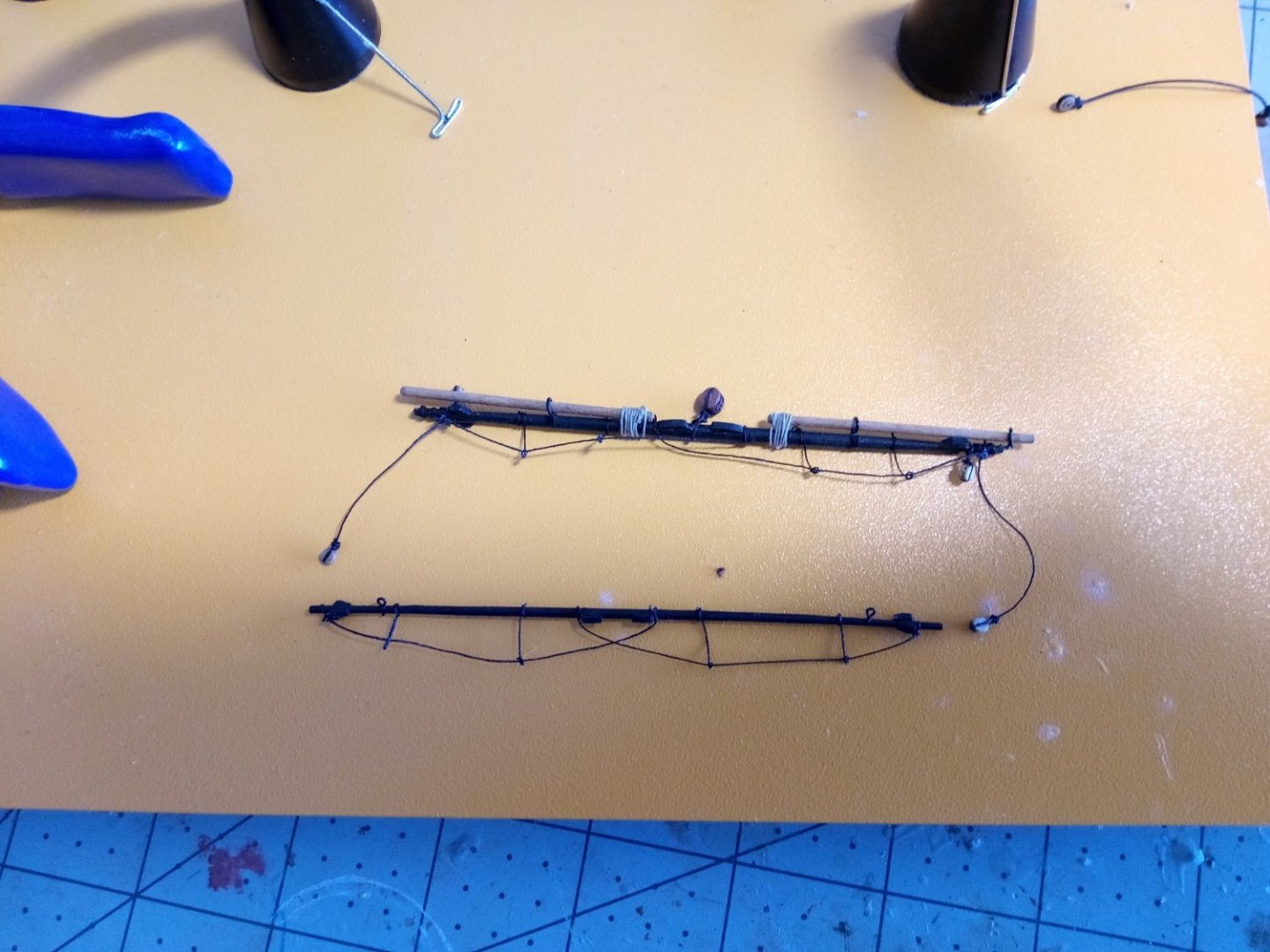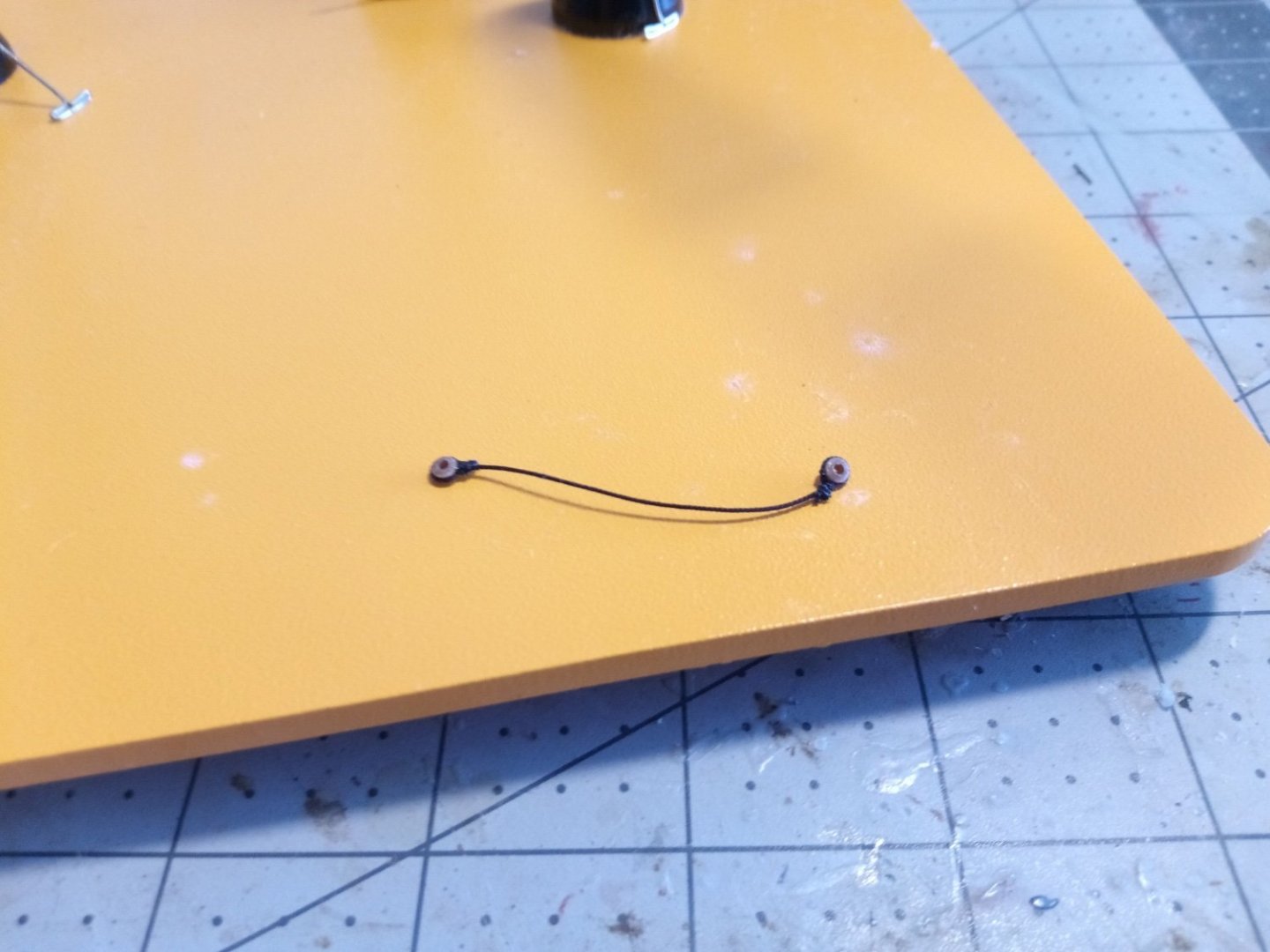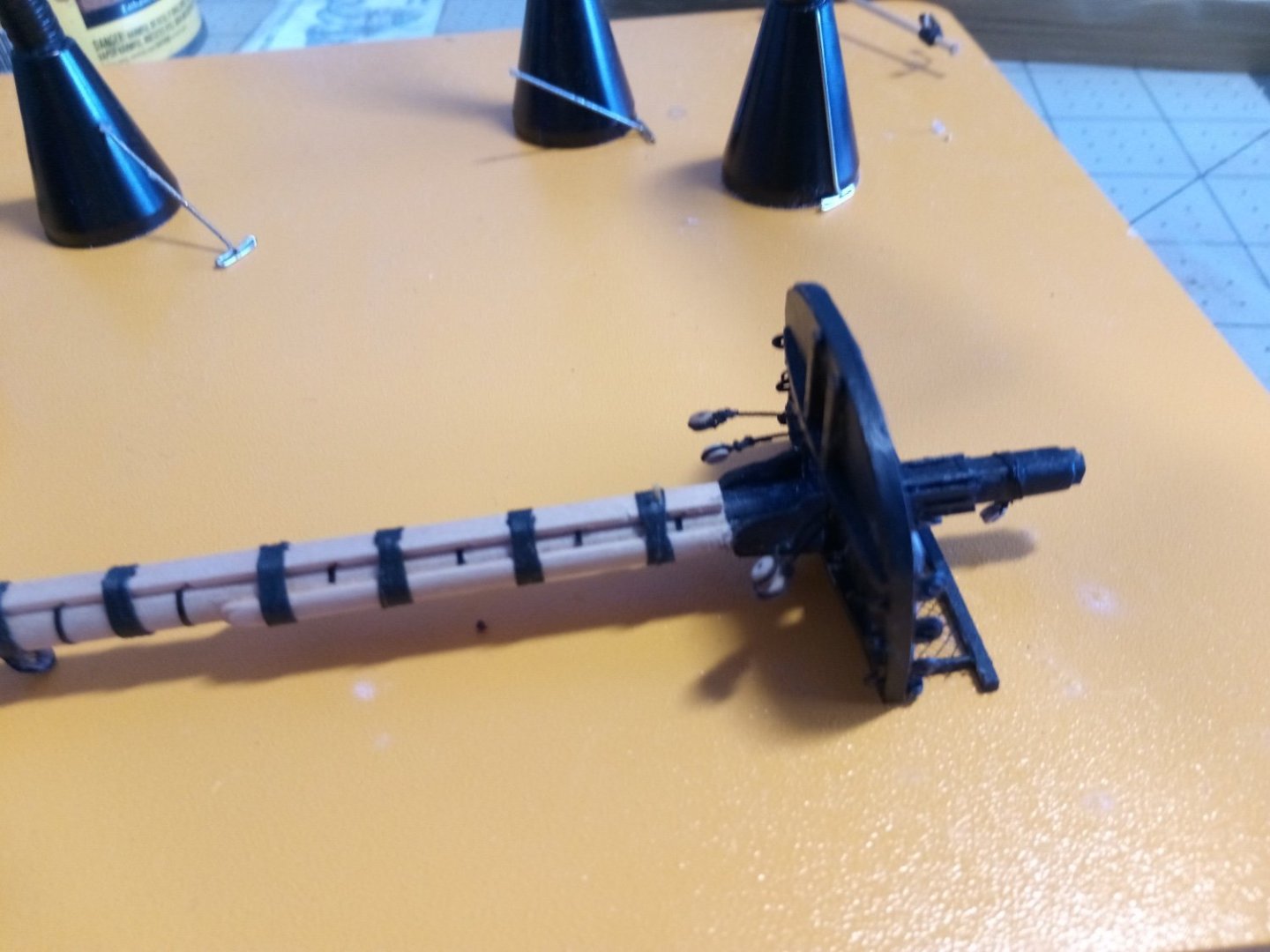-
Posts
739 -
Joined
-
Last visited
Content Type
Profiles
Forums
Gallery
Events
Everything posted by schooner
-
Launch and Recovery Cradle I would like to launch and recover the model off my dock which sits about 3 ft above the lake, I also needed something to safely “grab” the model if I had to take a boat out to recover it. I saw a cradle on the build log for a RC Liberty Ship over on the scratch build part of the site. Although that cradle was made of copper pipe for a much heavier model I thought I could get away with lighter, and easier to work with 1/2 inch PVC piping and fittings. Although it took a few trips to the hardware store to finally get everything I needed it was pretty easy to put together. The bottom is flat but someone with more PVC and design skill than I have could use 45-degree connectors to fashion a “V” bottom which would be best. I originally intended for the high “handle” section to just be straight up from one side but when I tried lifting it before glueing everything together I found that there was no way that would work, even without the weight of the model on it. I was able to use a couple of 45 degree connectors to move the handle over the centerline of the cradle so it lifts level without tilting. A couple of tips for anyone thinking about using PVC for a cradle: PVC is not buoyant, which is good because it’s easier to add flotation than weight. The primer and glue used to bond the PVC pieces sets up VERY quickly (less than 5 seconds) and very strong so you don’t get any do-overs if you don’t get the pieces aligned quickly Hardware stores carry 1/2 inch foam pipe insulation that fits perfectly around the PVC without need of glueing or taping unless you put it on a vertical section A PVC cutter works great but a saw will also work Don't forget to drill plenty of fill and drain holes - even the upper portions that never get wet, you don't want trapped air to mess up your desired floating depth The bathtub test took awhile. After adding enough flotation to get the thing to float it was VERY unstable - wanting to tip over in both directions. Adding, subtracting and shifting the foam flotation around didn’t make much difference. I finally figured out that the problem was that the high handle section raised the center of gravity above the center of buoyancy - something you don’t want for any floating object. I found that if I shifted all the foam pieces from the bottom horizontals the the upper ones, which are only about 3” higher, the problem was solved. I guess it really is better to be lucky than good. The cradle floats low enough in the water that the model can float free of it for launching and it can be driven back into it for recovery (the cross piece keeps it from driving thru it). The next step will be to try it on the lake, hopefully this week.
- 72 replies
-
- Seguin
- BlueJacket Shipcrafters
-
(and 2 more)
Tagged with:
-
Agree with the hobby shop recommendation. You might be having the same problem I had - everything worked great until I put the deck on and then things went bad. The problem was that the deck pushed on several wires causing them to move slightly - enough so that the weak solder connections would cut out. Not being a good solder guy I just removed them and twisted the wires together. Good luck - you are really close now.
- 296 replies
-
Fore Yard There is a lot of rigging to do in a small space in order to attach the fore yard (and the lower yards on all the masts). There are 4 sets of rigging that do different things: JEERS - 2 pairs of 3&4 sheeve blocks used to hoist the yard into position SLING - 2 bulls eyes lashed together to support the weight of the yard when it is in position TRUSSES - 2 heavy lines that loop around the yard and that are then passed thru thimbles (on their partner) behind the mast. They hold the yard to the mast and prevent it from pulling away under pressure of the fore sail NAVE LINE - I don’t understand how this one works - it is a small line that has 2 thimbles that go around the truss lines and it seems to be a way to either tension the trusses or to counter act the downward pull of the tackles that tighten the trusses Here is the yard with the sling, jeers, and truss lines pre-rigged on it: Here is the Nave line that sits behind the mast, just under the to: With the Fore Yard in place I’ve reached the limit of what I can reasonably rig to the mast prior to stepping it. There are about 40 shrouds, stays and running rigging lines that will have to be secured to belaying pins, tackles and deadeyes once the mast is mounted. I’ll be repeating all this for the other 2 masts and will post again when they are done.
- 142 replies
-
- alfred
- solid hull
-
(and 2 more)
Tagged with:
-
Just so you know - those are High Frequency(HF) fan antennas, 3 thin wires coming down to a common securing point with an insulator. Since the base is not painted with red as a warning for HF burn hazards they are likely receive antennas vice transmit. Either black thread or silver wire can be used to simulate them.
- 97 replies
-
- Curtis Wilbur
- I Love Kit
-
(and 2 more)
Tagged with:
-
Fore Topsail Yard The yard was pinned to the mast and the parrel beads added just like the topgallant yard. Instead of a simple halyard, as on the topgallant, there are two lines - the Halyard and the Tye, the are identical, just mirror images of each other on opposite sides of the mast. One of them is shown in the photo by the pink lines as it comes down from the crosstrees, passes thru a double block, back up thru a single block hanging from the cross trees and then down to just below and aft of the top where it terminates in a double block that will form the upper part of a tackle that will go on down to the outer edge of the main deck. The other item are the lifts, one per side, one of them is shown by the blue lines on the photo. They come down from the crosstrees, thru a single block at the yard end, up thru a single block near the cross trees, down thru the lubber hole and down to a pinrail on the deck. These lines look pretty sloppy because they are slack, they will look better when put under tension.
- 142 replies
-
- alfred
- solid hull
-
(and 2 more)
Tagged with:
-
Anchor Windlass The instructions recommend leaving the anchor windless off until the rigging is completed but I thought that might be tough to do with having to wrap the anchor cables around it so I checked the belaying points for all the belaying pins and tackles in that area and decided it would be best to do it now. I fabricated a few windless bars for the storage racks and then put the windlass and cables in place: Fore top gallant yard The halyard for the yard is just a line with an eye that turns it into a barrel hitch: Here the halyard is in place and the parallel beads are strung: The yard has been pinned to the mast, the parallels secured and the halyard has been run thru a “sheave” hole near the top of the mast and seized to a double block above a single block previously placed on the fighting top. The two blocks are reaved into a tackle, the bitter end will be belayed to one of the pintails on the main deck: The last things to add are the yard lifts and a flag:
- 142 replies
-
- alfred
- solid hull
-
(and 2 more)
Tagged with:
-
Not yet . I've got to put the ALFRED aside and spend a few hours assembling a carry/launching/recovery cradle from PVC. The lake has warmed up enough that I can go wading. Thanks for the reminder - I needed it.
- 72 replies
-
- Seguin
- BlueJacket Shipcrafters
-
(and 2 more)
Tagged with:
-
Almost all of the standing rigging has been added to the masts to include: upper shrouds & ratlines lower shrouds backstays forestays and their mouses (mice?) I’ll hold off adding the topgallant stays until later in the build because it would be very easy to snag one an break off a delicate topgallant mast The brass rods that are sitting near the top of the topgallant mast are just placeholders - they keep me from accidentally covering up the topgallant yard sheaves. Needing to take break from all the thread and tweezers I worked on a few minor items such as adding the stern lantern and ensign staff Fabricating the anchors Painting the gunport lids Next up will adding the yards to the foremast
- 142 replies
-
- alfred
- solid hull
-
(and 2 more)
Tagged with:
-
Great job!!! The hull lettering looks very nice, are they decals? stick on letters? painting stencils or something else?
- 29 replies
-
- Nantucket Lightship
- BlueJacket Shipcrafters
-
(and 1 more)
Tagged with:
-
Upper Ratlines I prepared for adding the upper ratlines by adding the Futtock Staves below the crosstrees and then the carpathans: The process of adding the ratlines was slow, mainly due to a case of “two steps forward, one step back” as I figured out how to tie them and then had to remove them to try something else. Although I use clove hitches on my “real” boat all the time they are made using rope (obviously) and usually tied around a horizontal bar. Trying to tie them with thread around another vertical thread kept confusing me. I finally found a great little video on Bruma’s build of the Revell plastic kit of the CUTTY SARK. His video is helpful because the thread is large, he works slowly and best of all, he uses tweezers for everything so his fingers are not blocking the view. It is on post # 366 of the attached: After watching it several times I finally got it in my head how to do it. My first attempt at tying clove hitches did not go well - I managed to get them crooked and many of the knots loosened up to the point that loops were clearly visible. Fortunately I had secured them with diluted white glue so they were easy to remove after brushing the knots with water. My second attempt went much better after I figured out how to cinch them tightly. Then the problem was that the knots were simply oversize at this scale. I tried some super fine thread I have but it was to too hard to see it and to manipulate it with tweezers so I decided to remove all the ratlines I had added to that point and to try gluing them to the shrouds. I’m satisfied with this result: Next up will be adding the backstays and the fore stays to the masts.
- 142 replies
-
- alfred
- solid hull
-
(and 2 more)
Tagged with:
-
Thanks Keith, Actually I did try that based on what I saw on your log. The threads I have to use for the upper shrouds at 1:96 are just too narrow (thin) to swing it, even with my wife's thinnest needle. I will try it again when I get to the lower (& thicker) shrouds. Keep up the great work on the Tennessee, she's a beauty.
- 399 replies
-
- cutty sark
- revell
-
(and 2 more)
Tagged with:
-
Great build and build log, nice clear photos! I really appreciate your posting of the video of how to do ratlines back in September. Although I use clove hitches all the time on my real boat somehow when using thread around another vertical thread I keep screwing it up. Your video is great because you tie the knots slowly and your use of tweezers keeps your fingers from blocking the view of what you are doing. I'm no in the process of tying stress-free clove hitches!
- 399 replies
-
- cutty sark
- revell
-
(and 2 more)
Tagged with:
-
I've seen a lot of "greening" ideas here on MSW but this looks like the best yet, looks great!!
- 96 replies
-
- Sphinx
- Vanguard Models
-
(and 2 more)
Tagged with:
-
Topmast Shrouds The shroud pairs and individual ones (odd number) were made up same as the lower ones: A simple jig like that found on countless other build logs was made up with 2 pieces of wire to fit into the upper and lower deadeyes to keep their spacing per the plans and the same to each of their neighbor’s: Once the shrouds were in place it was just a matter of reeving the lanyards thru the deadeyes and securing them: Next on the to -do list is rigging the Futtock Shrouds, the Catharpans (hopefully) and the ratlines.
- 142 replies
-
- alfred
- solid hull
-
(and 2 more)
Tagged with:
-
Rigging intentions and starting the lower shrouds As I get ready to start the rigging I thought it might be a good time to explain my plan for going about it, always subject to change since my plans/intentions/assumptions are blissfully free of relevant experience, this being my first real rigging job. Resources The kit’s instructions contain a general discussion of how to go about the rigging but they assume a level of experience/knowledge that I don’t have. The rigging diagram is one sheet of plans that shows all the standing and some of the running rigging - it is a real spaghetti pile that I find hard to pick out individual lines from but it is useful for figuring out shroud lengths and deadeye spacing. The instructions do contain good info with regard to line sizes and the belaying diagram is fine. I will be using a mix of kit-supplied Brittania metal blocks and wood ones from SYREN Ship Model Co. For rigging line I will be using a lot from SYREN with the sizes being the closest match available to the kit’s. I’ll be using Lennarth Peterson’s Rigging Period Ship Models as my primary reference for what to rig. The book is based on the late 18th century Royal Navy Frigate HMS Melampus. It has almost NO text but is made up of a clear diagram for each rigging line. It has the advantage that they are arranged in a sequence that makes sense for rigging a model with minimal interference between new and previously-rigged lines. The book does not contain any information about line or block sizes nor are the diagrams to any consistent scale so dimensions are not useful. It does have diagrams of all sails and their rigging for those who want to go that far and it does have belaying diagrams although I will be using the kit instructions since ALFRED had a lot fewer belaying pins than MELAMPUS. The differences between ALFRED and MELAMPUS are mainly ones of subtraction; ALFRED did not have a spanker boom, martingales, boomkins, flying jib, spirit sail topsail yard or royal yards. General plan of attack This is going to be a challenging rigging job because of space constraints. To start with ALFRED was a small ship and at 1:96 (1/8”) scale there is little room to work on belaying rigging, for example there is less than one inch separating the aftermost deadeye on the main chains from the forward most on the mizzen chains. Because of this I plan on including all of the standing rigging but only those running rigging lines that are associated with controlling and securing the yards (i.e halyards/slings/jeers, lifts, and braces). I will also attempt to rig each mast as much as possible, including the upper shrouds and the yards, before stepping them so that I can secure the running rigging lines that are tied off around the mast bases and many of the stays before securing the shrouds. Starting the lower shrouds After dry fitting each mast in place I used a piece of line to determine the shroud length for each mast, leaving what I hope is enough extra to allow for seizing around the deadeyes. I held off attaching the topmasts so that I could make up the shrouds off the mast and then slip them over the masthead before the mast caps are installed. The shroud loops are secured with an unglued seizing that can be cinched up to the mast head and then brushed with diluted white glue. All 16 shrouds were easy to make up in this manner and were added to the masts, alternating each pair, starboard to port and forward to aft. They are all labeled with a small piece of tape holding the pairs together.
- 142 replies
-
- alfred
- solid hull
-
(and 2 more)
Tagged with:
-
Nice clear explanation and photos!
- 587 replies
-
- Indefatigable
- Vanguard Models
-
(and 1 more)
Tagged with:
-
Foot ropes and Burton Pendants I’d originally planned (hoped) to use some very small eyebolts I have on hand for the foot rope stirrups (the vertical lines that hold up the inner portions of the foot ropes). Unfortunately at this scale the upper yards are too thin to withstand drilling with even a #74 bit so I had to go with thread. After some trial and error I finally settled on making the stirrups by starting with an overhand knot tied around a needle to form an eye and spot glued to hold it. The stirrup was then led down the aft side of the yard and tied off to the eye would be 2-3 scale feet below the bottom of the yard. The foot rope was then tied off and one end, threaded thru the stirrups and secured at the other end. Once fabricated the stirrups were weighted with some small clothespins and everything was brushed with diluted white glue to stiffen them. Next up was what has got to be the easiest part of the whole rigging process - the Burton Pendants which were anchoring points for blocks when handling heavy loads on deck. Two bullseyes were seized at opposite ends of a piece of line, they are then looped over the crosstrees of the tops and upper shrouds. The Fore and Main masts get 4 lower ones and 2 upper, the Mizzen just gets 2 lower ones. The pendants will all get the white glue treatment to keep them hanging vertical. Next up will be adding the lower shrouds to the masts.
- 142 replies
-
- alfred
- solid hull
-
(and 2 more)
Tagged with:
-
Agree with the 2 footers being the largest practical size for a model that does not become a piece of furniture when cased, at least for sailing ships. As far as specific ships I think the cutter Bear or the west coast schooners Wawona or Thayer would be great. As far as USN subjects the armored cruisers of the Tennessee class (4 ships) were stunning in their as built white rig, plus each was first named for a state and later renamed after a city so that might increase their marketability/appeal.
-
Thanks for the kind words and the likes. I've been plugging away on the foot ropes and will then double check to make sure I have mounted all the blocks on the masts that I can at this point and then it will be time to actually start rigging (finally!).
- 142 replies
-
- alfred
- solid hull
-
(and 2 more)
Tagged with:
-
Wonderful build! Congratulations on reaching the finish line and thanks for taking the time on the log. I see more builders from North Carolina here on MSW than any place outside the UK, a little odd considering NC was never a hotbed of 18th or 19th century shipbuilding.
- 233 replies
-
- Indefatigable
- Vanguard Models
-
(and 1 more)
Tagged with:
About us
Modelshipworld - Advancing Ship Modeling through Research
SSL Secured
Your security is important for us so this Website is SSL-Secured
NRG Mailing Address
Nautical Research Guild
237 South Lincoln Street
Westmont IL, 60559-1917
Model Ship World ® and the MSW logo are Registered Trademarks, and belong to the Nautical Research Guild (United States Patent and Trademark Office: No. 6,929,264 & No. 6,929,274, registered Dec. 20, 2022)
Helpful Links
About the NRG
If you enjoy building ship models that are historically accurate as well as beautiful, then The Nautical Research Guild (NRG) is just right for you.
The Guild is a non-profit educational organization whose mission is to “Advance Ship Modeling Through Research”. We provide support to our members in their efforts to raise the quality of their model ships.
The Nautical Research Guild has published our world-renowned quarterly magazine, The Nautical Research Journal, since 1955. The pages of the Journal are full of articles by accomplished ship modelers who show you how they create those exquisite details on their models, and by maritime historians who show you the correct details to build. The Journal is available in both print and digital editions. Go to the NRG web site (www.thenrg.org) to download a complimentary digital copy of the Journal. The NRG also publishes plan sets, books and compilations of back issues of the Journal and the former Ships in Scale and Model Ship Builder magazines.


